Financial Ratio Analysis of Sports Direct vs JD Sports Fashion
VerifiedAdded on 2023/01/11
|27
|4025
|26
Report
AI Summary
This report presents a comprehensive financial analysis of Sports Direct plc and JD Sports Fashion Limited, focusing on their performance, financial position, and investment potential. The analysis employs various financial ratios, including current ratio, quick ratio, net profit margin, gross profit margin, gearing ratio, price-earnings ratio, earnings per share, return on capital employed, inventory turnover ratio, and dividend payout ratio. The report compares the two companies across these metrics for the years 2017 and 2018, highlighting their strengths and weaknesses. Recommendations are provided to improve the performance of each company, focusing on enhancing profitability, managing inventory, and optimizing share value. Additionally, the report discusses the limitations of relying solely on financial ratios for interpreting a company's performance, considering factors like historical data, inflation, accounting policy changes, and potential financial statement manipulation. The conclusion emphasizes the importance of a holistic approach to financial analysis, considering both quantitative and qualitative factors.

MANAGERIAL FINANCE
Paraphrase This Document
Need a fresh take? Get an instant paraphrase of this document with our AI Paraphraser
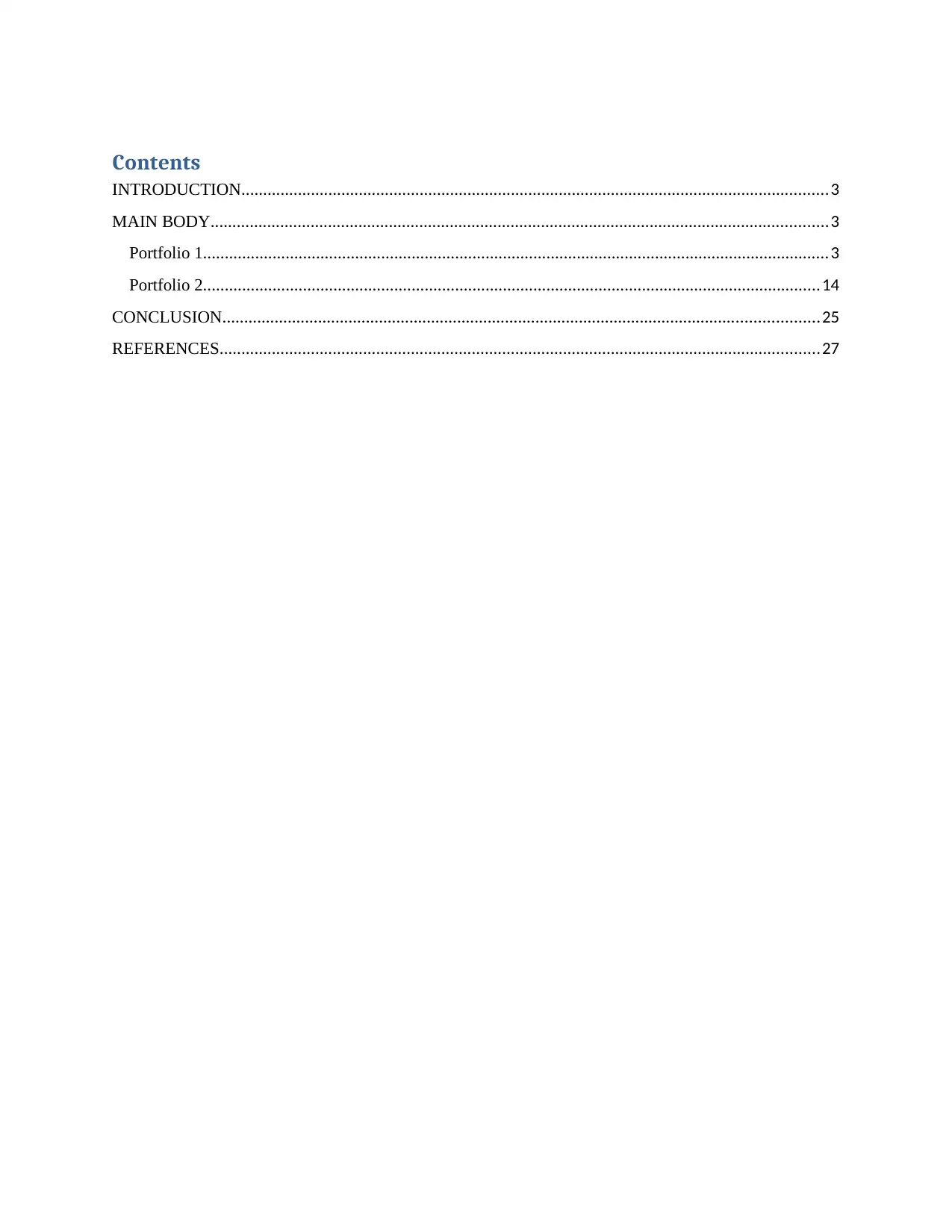
Contents
INTRODUCTION.......................................................................................................................................3
MAIN BODY..............................................................................................................................................3
Portfolio 1................................................................................................................................................3
Portfolio 2..............................................................................................................................................14
CONCLUSION.........................................................................................................................................25
REFERENCES..........................................................................................................................................27
INTRODUCTION.......................................................................................................................................3
MAIN BODY..............................................................................................................................................3
Portfolio 1................................................................................................................................................3
Portfolio 2..............................................................................................................................................14
CONCLUSION.........................................................................................................................................25
REFERENCES..........................................................................................................................................27
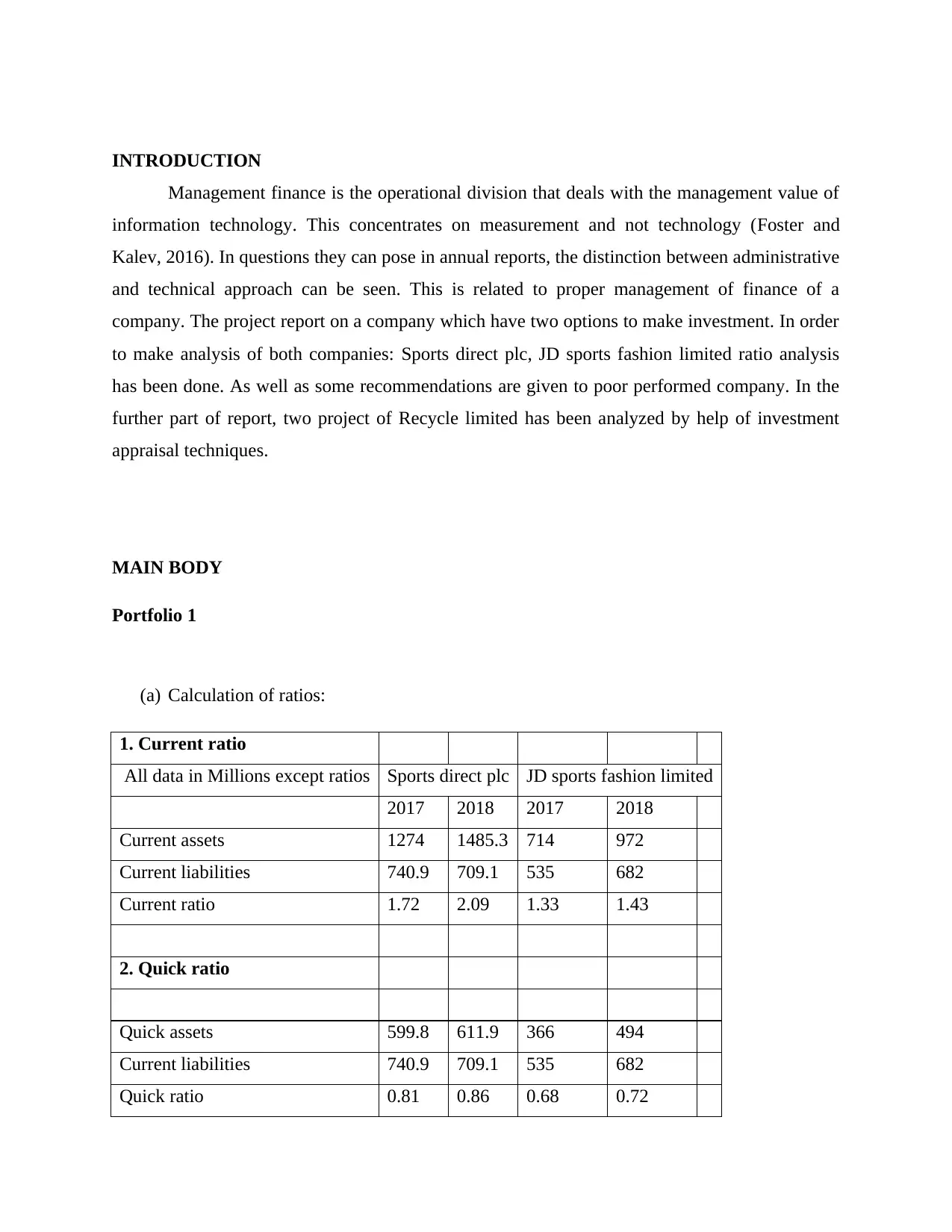
INTRODUCTION
Management finance is the operational division that deals with the management value of
information technology. This concentrates on measurement and not technology (Foster and
Kalev, 2016). In questions they can pose in annual reports, the distinction between administrative
and technical approach can be seen. This is related to proper management of finance of a
company. The project report on a company which have two options to make investment. In order
to make analysis of both companies: Sports direct plc, JD sports fashion limited ratio analysis
has been done. As well as some recommendations are given to poor performed company. In the
further part of report, two project of Recycle limited has been analyzed by help of investment
appraisal techniques.
MAIN BODY
Portfolio 1
(a) Calculation of ratios:
1. Current ratio
All data in Millions except ratios Sports direct plc JD sports fashion limited
2017 2018 2017 2018
Current assets 1274 1485.3 714 972
Current liabilities 740.9 709.1 535 682
Current ratio 1.72 2.09 1.33 1.43
2. Quick ratio
Quick assets 599.8 611.9 366 494
Current liabilities 740.9 709.1 535 682
Quick ratio 0.81 0.86 0.68 0.72
Management finance is the operational division that deals with the management value of
information technology. This concentrates on measurement and not technology (Foster and
Kalev, 2016). In questions they can pose in annual reports, the distinction between administrative
and technical approach can be seen. This is related to proper management of finance of a
company. The project report on a company which have two options to make investment. In order
to make analysis of both companies: Sports direct plc, JD sports fashion limited ratio analysis
has been done. As well as some recommendations are given to poor performed company. In the
further part of report, two project of Recycle limited has been analyzed by help of investment
appraisal techniques.
MAIN BODY
Portfolio 1
(a) Calculation of ratios:
1. Current ratio
All data in Millions except ratios Sports direct plc JD sports fashion limited
2017 2018 2017 2018
Current assets 1274 1485.3 714 972
Current liabilities 740.9 709.1 535 682
Current ratio 1.72 2.09 1.33 1.43
2. Quick ratio
Quick assets 599.8 611.9 366 494
Current liabilities 740.9 709.1 535 682
Quick ratio 0.81 0.86 0.68 0.72
You're viewing a preview
Unlock full access by subscribing today!
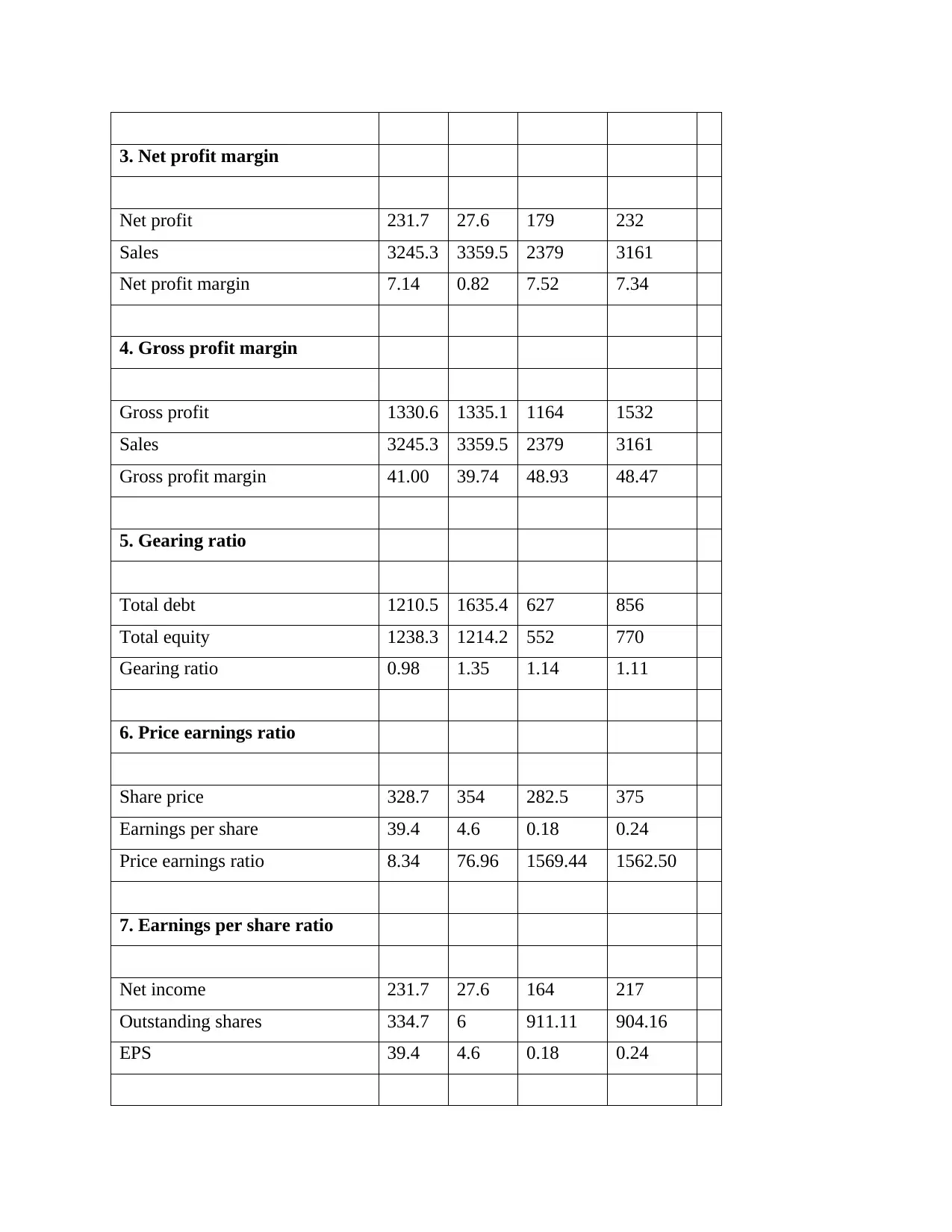
3. Net profit margin
Net profit 231.7 27.6 179 232
Sales 3245.3 3359.5 2379 3161
Net profit margin 7.14 0.82 7.52 7.34
4. Gross profit margin
Gross profit 1330.6 1335.1 1164 1532
Sales 3245.3 3359.5 2379 3161
Gross profit margin 41.00 39.74 48.93 48.47
5. Gearing ratio
Total debt 1210.5 1635.4 627 856
Total equity 1238.3 1214.2 552 770
Gearing ratio 0.98 1.35 1.14 1.11
6. Price earnings ratio
Share price 328.7 354 282.5 375
Earnings per share 39.4 4.6 0.18 0.24
Price earnings ratio 8.34 76.96 1569.44 1562.50
7. Earnings per share ratio
Net income 231.7 27.6 164 217
Outstanding shares 334.7 6 911.11 904.16
EPS 39.4 4.6 0.18 0.24
Net profit 231.7 27.6 179 232
Sales 3245.3 3359.5 2379 3161
Net profit margin 7.14 0.82 7.52 7.34
4. Gross profit margin
Gross profit 1330.6 1335.1 1164 1532
Sales 3245.3 3359.5 2379 3161
Gross profit margin 41.00 39.74 48.93 48.47
5. Gearing ratio
Total debt 1210.5 1635.4 627 856
Total equity 1238.3 1214.2 552 770
Gearing ratio 0.98 1.35 1.14 1.11
6. Price earnings ratio
Share price 328.7 354 282.5 375
Earnings per share 39.4 4.6 0.18 0.24
Price earnings ratio 8.34 76.96 1569.44 1562.50
7. Earnings per share ratio
Net income 231.7 27.6 164 217
Outstanding shares 334.7 6 911.11 904.16
EPS 39.4 4.6 0.18 0.24
Paraphrase This Document
Need a fresh take? Get an instant paraphrase of this document with our AI Paraphraser
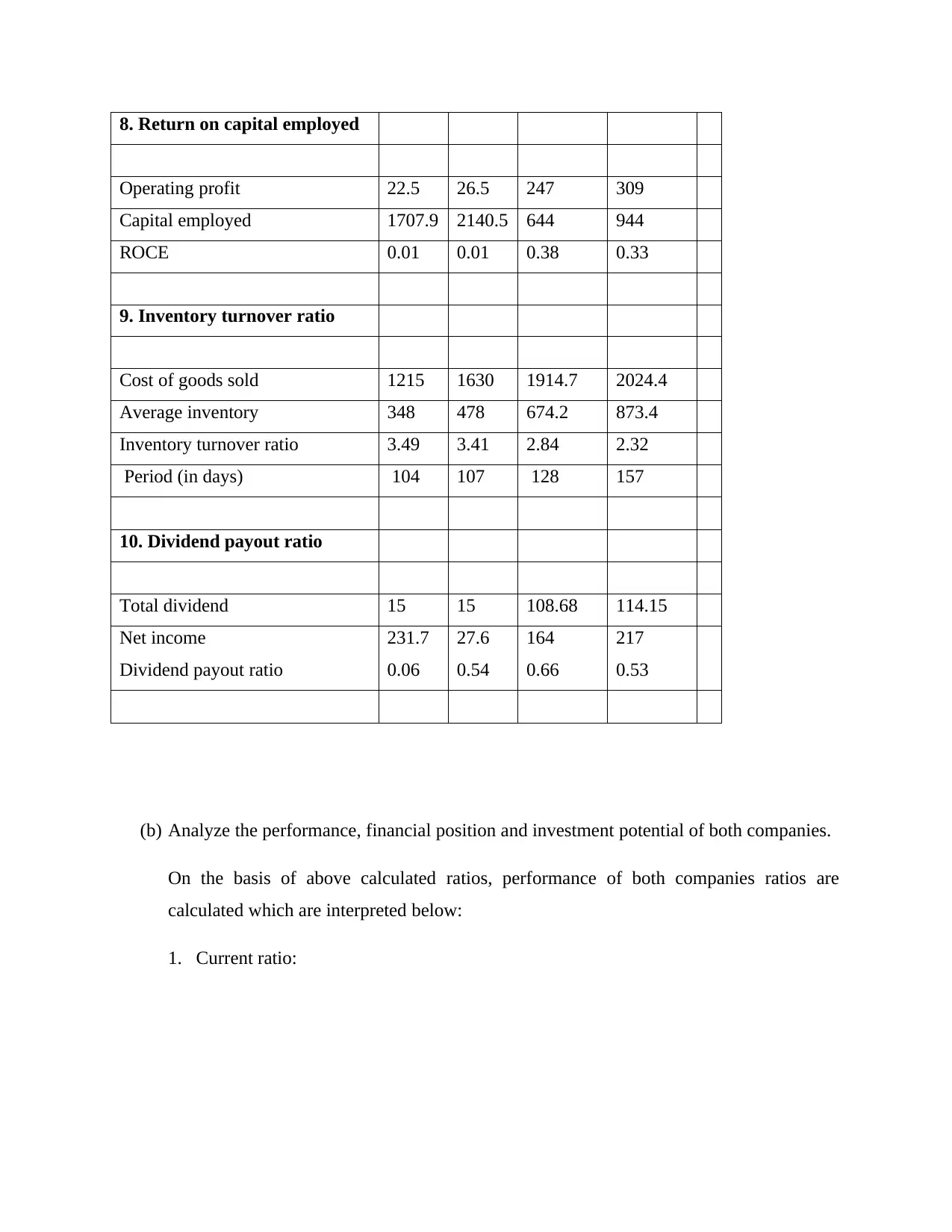
8. Return on capital employed
Operating profit 22.5 26.5 247 309
Capital employed 1707.9 2140.5 644 944
ROCE 0.01 0.01 0.38 0.33
9. Inventory turnover ratio
Cost of goods sold 1215 1630 1914.7 2024.4
Average inventory 348 478 674.2 873.4
Inventory turnover ratio 3.49 3.41 2.84 2.32
Period (in days) 104 107 128 157
10. Dividend payout ratio
Total dividend 15 15 108.68 114.15
Net income 231.7 27.6 164 217
Dividend payout ratio 0.06 0.54 0.66 0.53
(b) Analyze the performance, financial position and investment potential of both companies.
On the basis of above calculated ratios, performance of both companies ratios are
calculated which are interpreted below:
1. Current ratio:
Operating profit 22.5 26.5 247 309
Capital employed 1707.9 2140.5 644 944
ROCE 0.01 0.01 0.38 0.33
9. Inventory turnover ratio
Cost of goods sold 1215 1630 1914.7 2024.4
Average inventory 348 478 674.2 873.4
Inventory turnover ratio 3.49 3.41 2.84 2.32
Period (in days) 104 107 128 157
10. Dividend payout ratio
Total dividend 15 15 108.68 114.15
Net income 231.7 27.6 164 217
Dividend payout ratio 0.06 0.54 0.66 0.53
(b) Analyze the performance, financial position and investment potential of both companies.
On the basis of above calculated ratios, performance of both companies ratios are
calculated which are interpreted below:
1. Current ratio:
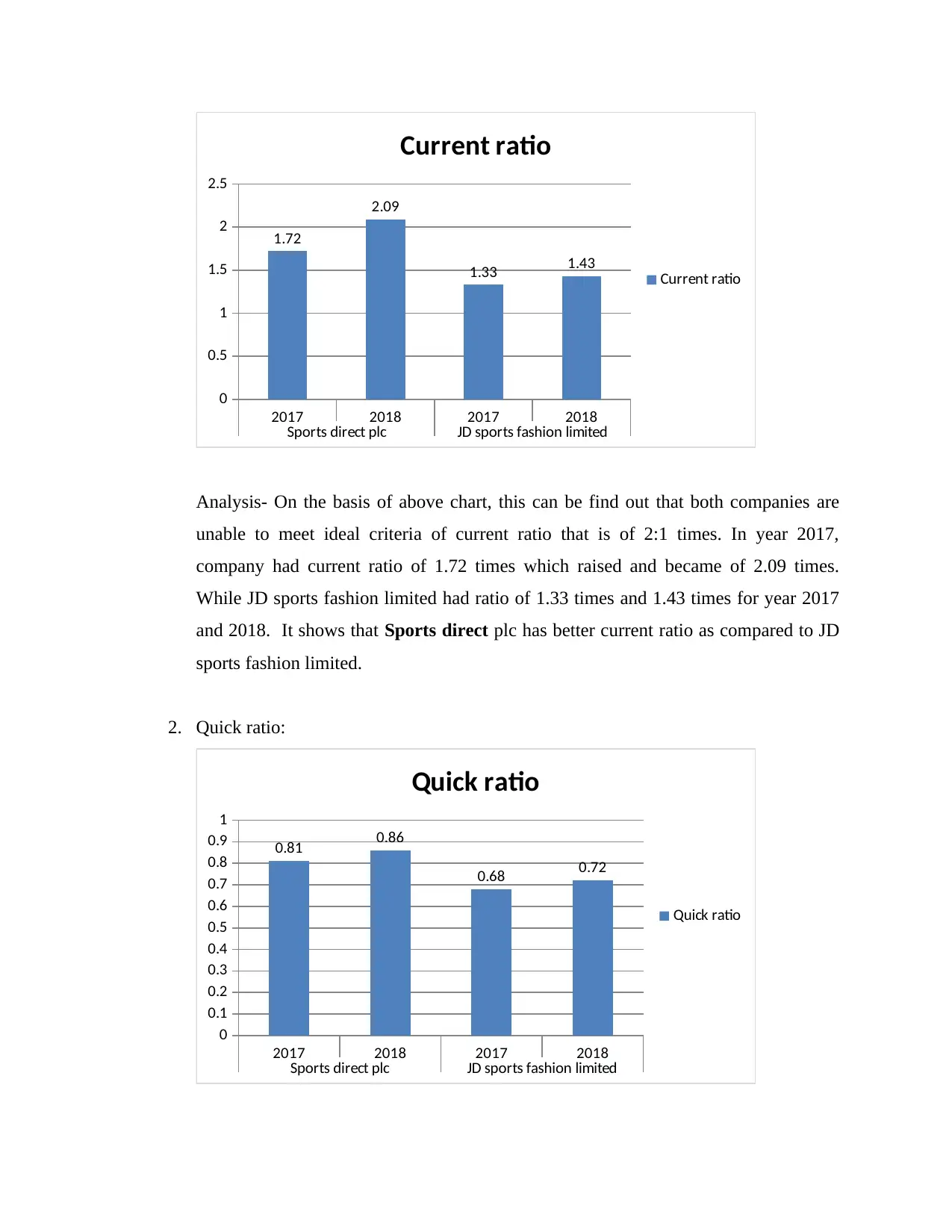
2017 2018 2017 2018
Sports direct plc JD sports fashion limited
0
0.5
1
1.5
2
2.5
1.72
2.09
1.33 1.43
Current ratio
Current ratio
Analysis- On the basis of above chart, this can be find out that both companies are
unable to meet ideal criteria of current ratio that is of 2:1 times. In year 2017,
company had current ratio of 1.72 times which raised and became of 2.09 times.
While JD sports fashion limited had ratio of 1.33 times and 1.43 times for year 2017
and 2018. It shows that Sports direct plc has better current ratio as compared to JD
sports fashion limited.
2. Quick ratio:
2017 2018 2017 2018
Sports direct plc JD sports fashion limited
0
0.1
0.2
0.3
0.4
0.5
0.6
0.7
0.8
0.9
1
0.81 0.86
0.68 0.72
Quick ratio
Quick ratio
Sports direct plc JD sports fashion limited
0
0.5
1
1.5
2
2.5
1.72
2.09
1.33 1.43
Current ratio
Current ratio
Analysis- On the basis of above chart, this can be find out that both companies are
unable to meet ideal criteria of current ratio that is of 2:1 times. In year 2017,
company had current ratio of 1.72 times which raised and became of 2.09 times.
While JD sports fashion limited had ratio of 1.33 times and 1.43 times for year 2017
and 2018. It shows that Sports direct plc has better current ratio as compared to JD
sports fashion limited.
2. Quick ratio:
2017 2018 2017 2018
Sports direct plc JD sports fashion limited
0
0.1
0.2
0.3
0.4
0.5
0.6
0.7
0.8
0.9
1
0.81 0.86
0.68 0.72
Quick ratio
Quick ratio
You're viewing a preview
Unlock full access by subscribing today!
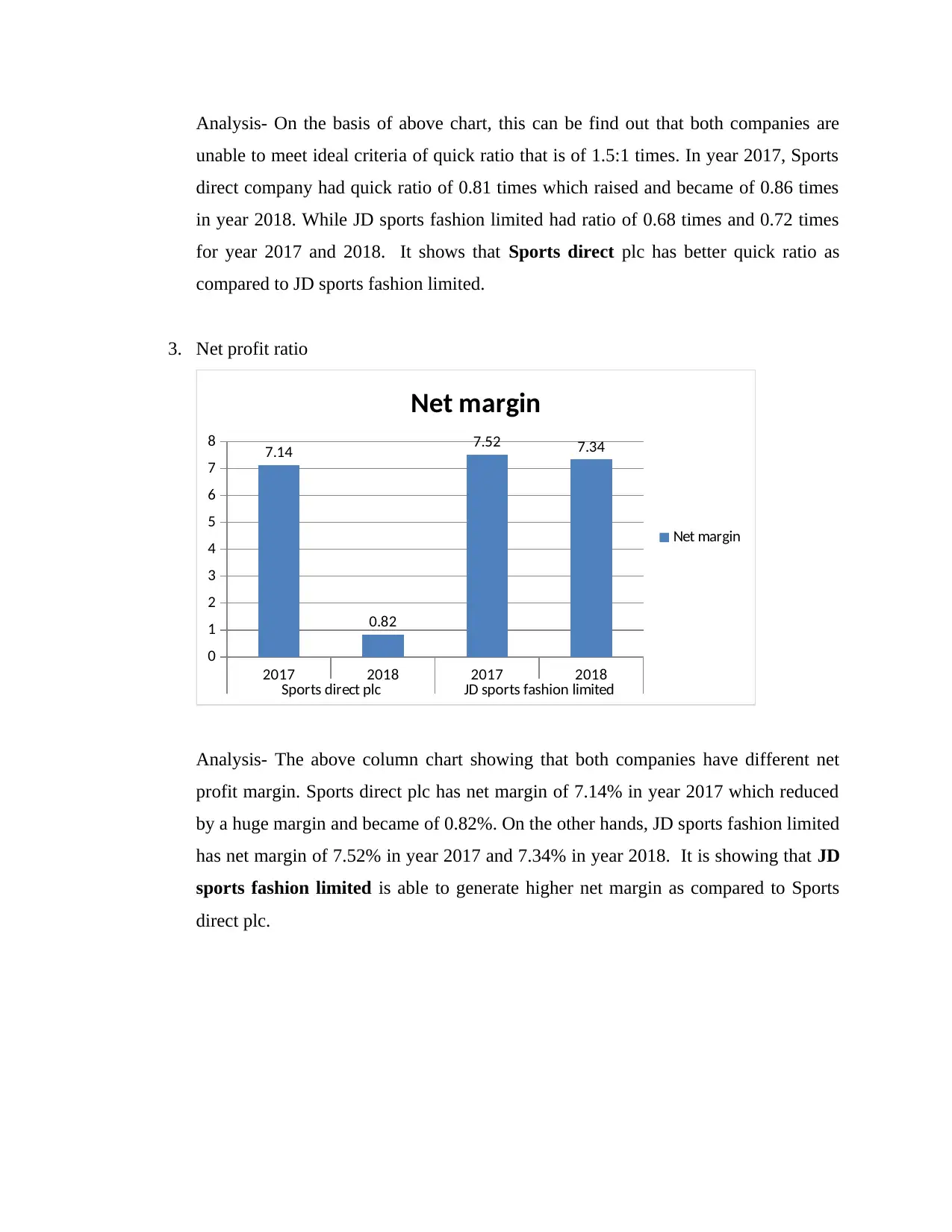
Analysis- On the basis of above chart, this can be find out that both companies are
unable to meet ideal criteria of quick ratio that is of 1.5:1 times. In year 2017, Sports
direct company had quick ratio of 0.81 times which raised and became of 0.86 times
in year 2018. While JD sports fashion limited had ratio of 0.68 times and 0.72 times
for year 2017 and 2018. It shows that Sports direct plc has better quick ratio as
compared to JD sports fashion limited.
3. Net profit ratio
2017 2018 2017 2018
Sports direct plc JD sports fashion limited
0
1
2
3
4
5
6
7
8 7.14
0.82
7.52 7.34
Net margin
Net margin
Analysis- The above column chart showing that both companies have different net
profit margin. Sports direct plc has net margin of 7.14% in year 2017 which reduced
by a huge margin and became of 0.82%. On the other hands, JD sports fashion limited
has net margin of 7.52% in year 2017 and 7.34% in year 2018. It is showing that JD
sports fashion limited is able to generate higher net margin as compared to Sports
direct plc.
unable to meet ideal criteria of quick ratio that is of 1.5:1 times. In year 2017, Sports
direct company had quick ratio of 0.81 times which raised and became of 0.86 times
in year 2018. While JD sports fashion limited had ratio of 0.68 times and 0.72 times
for year 2017 and 2018. It shows that Sports direct plc has better quick ratio as
compared to JD sports fashion limited.
3. Net profit ratio
2017 2018 2017 2018
Sports direct plc JD sports fashion limited
0
1
2
3
4
5
6
7
8 7.14
0.82
7.52 7.34
Net margin
Net margin
Analysis- The above column chart showing that both companies have different net
profit margin. Sports direct plc has net margin of 7.14% in year 2017 which reduced
by a huge margin and became of 0.82%. On the other hands, JD sports fashion limited
has net margin of 7.52% in year 2017 and 7.34% in year 2018. It is showing that JD
sports fashion limited is able to generate higher net margin as compared to Sports
direct plc.
Paraphrase This Document
Need a fresh take? Get an instant paraphrase of this document with our AI Paraphraser
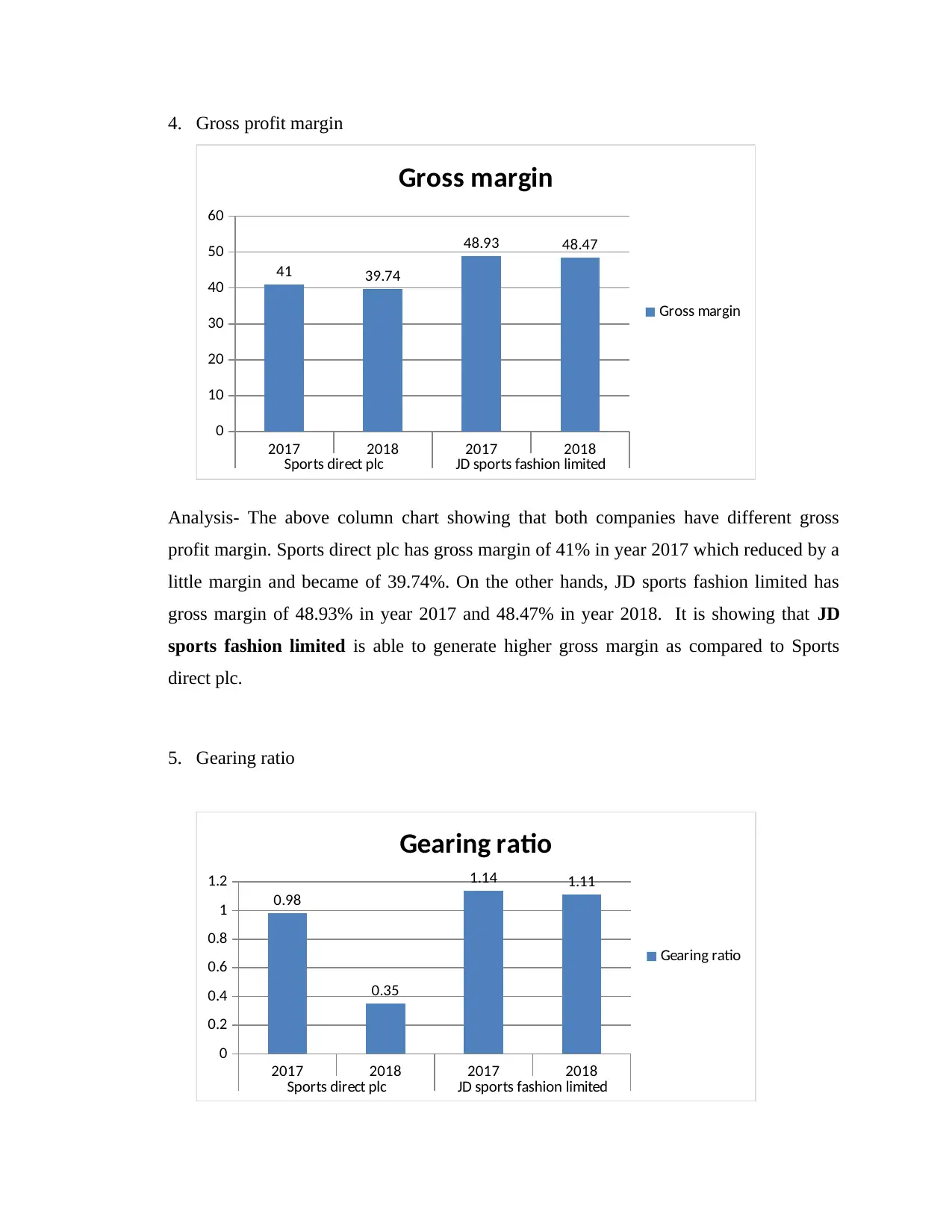
4. Gross profit margin
2017 2018 2017 2018
Sports direct plc JD sports fashion limited
0
10
20
30
40
50
60
41 39.74
48.93 48.47
Gross margin
Gross margin
Analysis- The above column chart showing that both companies have different gross
profit margin. Sports direct plc has gross margin of 41% in year 2017 which reduced by a
little margin and became of 39.74%. On the other hands, JD sports fashion limited has
gross margin of 48.93% in year 2017 and 48.47% in year 2018. It is showing that JD
sports fashion limited is able to generate higher gross margin as compared to Sports
direct plc.
5. Gearing ratio
2017 2018 2017 2018
Sports direct plc JD sports fashion limited
0
0.2
0.4
0.6
0.8
1
1.2
0.98
0.35
1.14 1.11
Gearing ratio
Gearing ratio
2017 2018 2017 2018
Sports direct plc JD sports fashion limited
0
10
20
30
40
50
60
41 39.74
48.93 48.47
Gross margin
Gross margin
Analysis- The above column chart showing that both companies have different gross
profit margin. Sports direct plc has gross margin of 41% in year 2017 which reduced by a
little margin and became of 39.74%. On the other hands, JD sports fashion limited has
gross margin of 48.93% in year 2017 and 48.47% in year 2018. It is showing that JD
sports fashion limited is able to generate higher gross margin as compared to Sports
direct plc.
5. Gearing ratio
2017 2018 2017 2018
Sports direct plc JD sports fashion limited
0
0.2
0.4
0.6
0.8
1
1.2
0.98
0.35
1.14 1.11
Gearing ratio
Gearing ratio
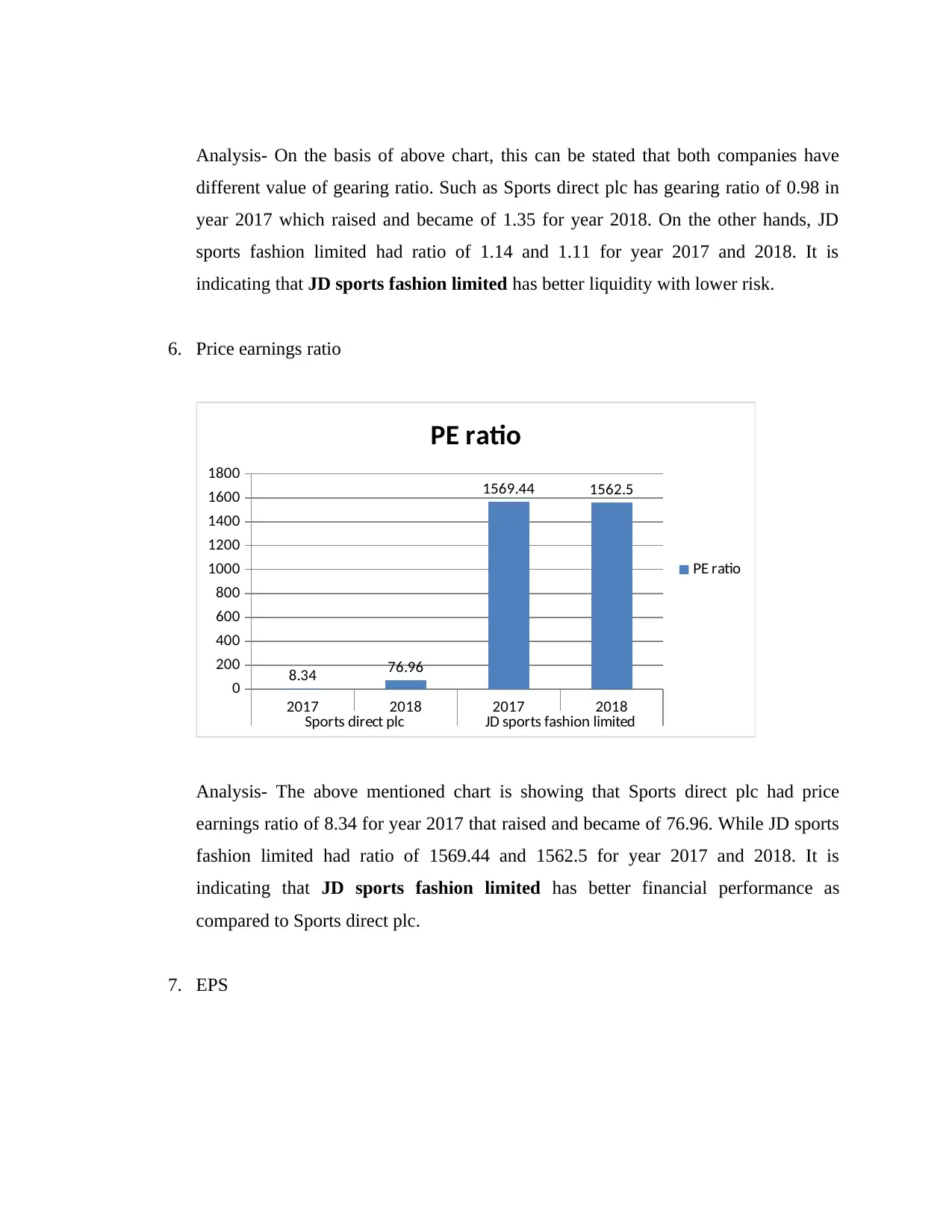
Analysis- On the basis of above chart, this can be stated that both companies have
different value of gearing ratio. Such as Sports direct plc has gearing ratio of 0.98 in
year 2017 which raised and became of 1.35 for year 2018. On the other hands, JD
sports fashion limited had ratio of 1.14 and 1.11 for year 2017 and 2018. It is
indicating that JD sports fashion limited has better liquidity with lower risk.
6. Price earnings ratio
2017 2018 2017 2018
Sports direct plc JD sports fashion limited
0
200
400
600
800
1000
1200
1400
1600
1800
8.34 76.96
1569.44 1562.5
PE ratio
PE ratio
Analysis- The above mentioned chart is showing that Sports direct plc had price
earnings ratio of 8.34 for year 2017 that raised and became of 76.96. While JD sports
fashion limited had ratio of 1569.44 and 1562.5 for year 2017 and 2018. It is
indicating that JD sports fashion limited has better financial performance as
compared to Sports direct plc.
7. EPS
different value of gearing ratio. Such as Sports direct plc has gearing ratio of 0.98 in
year 2017 which raised and became of 1.35 for year 2018. On the other hands, JD
sports fashion limited had ratio of 1.14 and 1.11 for year 2017 and 2018. It is
indicating that JD sports fashion limited has better liquidity with lower risk.
6. Price earnings ratio
2017 2018 2017 2018
Sports direct plc JD sports fashion limited
0
200
400
600
800
1000
1200
1400
1600
1800
8.34 76.96
1569.44 1562.5
PE ratio
PE ratio
Analysis- The above mentioned chart is showing that Sports direct plc had price
earnings ratio of 8.34 for year 2017 that raised and became of 76.96. While JD sports
fashion limited had ratio of 1569.44 and 1562.5 for year 2017 and 2018. It is
indicating that JD sports fashion limited has better financial performance as
compared to Sports direct plc.
7. EPS
You're viewing a preview
Unlock full access by subscribing today!
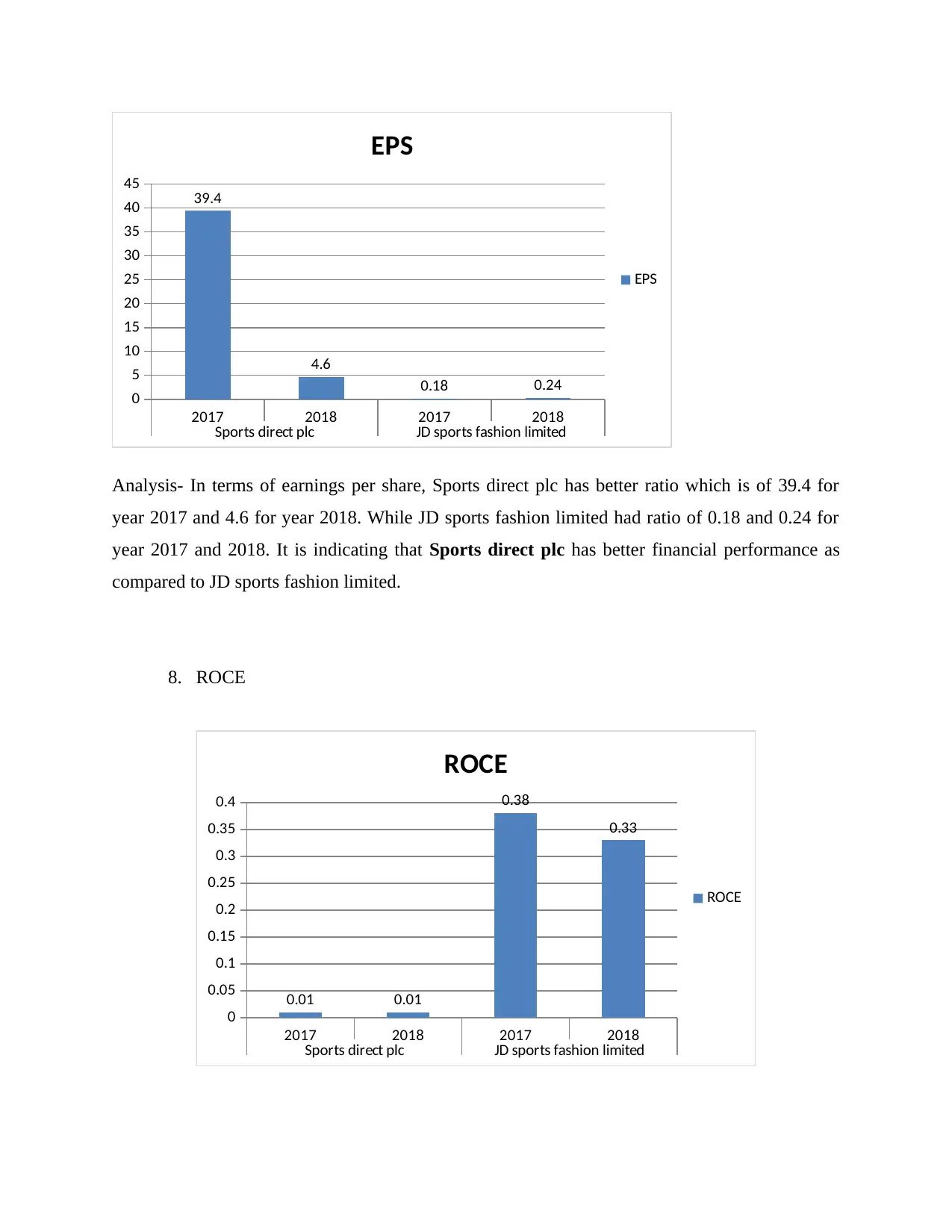
2017 2018 2017 2018
Sports direct plc JD sports fashion limited
0
5
10
15
20
25
30
35
40
45 39.4
4.6
0.18 0.24
EPS
EPS
Analysis- In terms of earnings per share, Sports direct plc has better ratio which is of 39.4 for
year 2017 and 4.6 for year 2018. While JD sports fashion limited had ratio of 0.18 and 0.24 for
year 2017 and 2018. It is indicating that Sports direct plc has better financial performance as
compared to JD sports fashion limited.
8. ROCE
2017 2018 2017 2018
Sports direct plc JD sports fashion limited
0
0.05
0.1
0.15
0.2
0.25
0.3
0.35
0.4
0.01 0.01
0.38
0.33
ROCE
ROCE
Sports direct plc JD sports fashion limited
0
5
10
15
20
25
30
35
40
45 39.4
4.6
0.18 0.24
EPS
EPS
Analysis- In terms of earnings per share, Sports direct plc has better ratio which is of 39.4 for
year 2017 and 4.6 for year 2018. While JD sports fashion limited had ratio of 0.18 and 0.24 for
year 2017 and 2018. It is indicating that Sports direct plc has better financial performance as
compared to JD sports fashion limited.
8. ROCE
2017 2018 2017 2018
Sports direct plc JD sports fashion limited
0
0.05
0.1
0.15
0.2
0.25
0.3
0.35
0.4
0.01 0.01
0.38
0.33
ROCE
ROCE
Paraphrase This Document
Need a fresh take? Get an instant paraphrase of this document with our AI Paraphraser
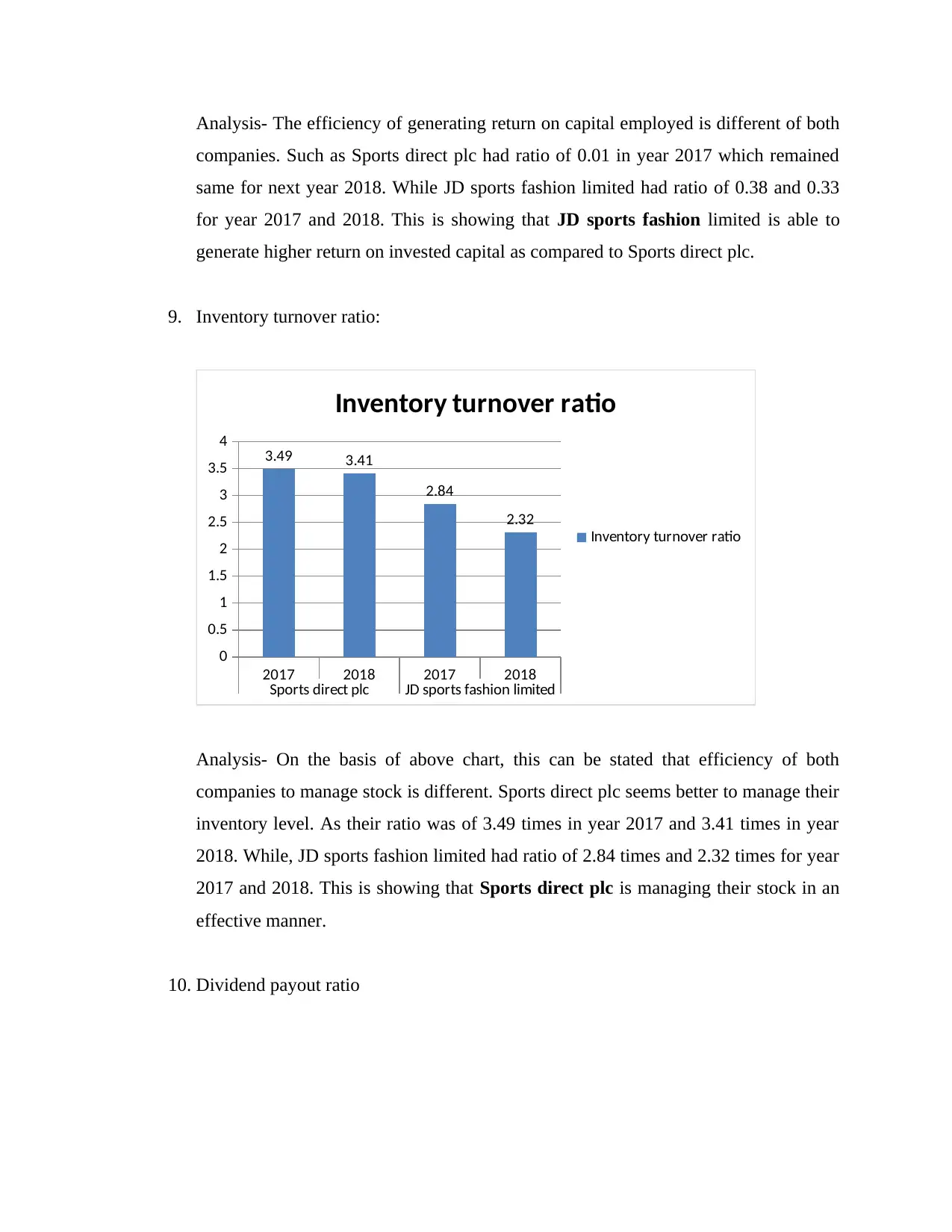
Analysis- The efficiency of generating return on capital employed is different of both
companies. Such as Sports direct plc had ratio of 0.01 in year 2017 which remained
same for next year 2018. While JD sports fashion limited had ratio of 0.38 and 0.33
for year 2017 and 2018. This is showing that JD sports fashion limited is able to
generate higher return on invested capital as compared to Sports direct plc.
9. Inventory turnover ratio:
2017 2018 2017 2018
Sports direct plc JD sports fashion limited
0
0.5
1
1.5
2
2.5
3
3.5
4 3.49 3.41
2.84
2.32
Inventory turnover ratio
Inventory turnover ratio
Analysis- On the basis of above chart, this can be stated that efficiency of both
companies to manage stock is different. Sports direct plc seems better to manage their
inventory level. As their ratio was of 3.49 times in year 2017 and 3.41 times in year
2018. While, JD sports fashion limited had ratio of 2.84 times and 2.32 times for year
2017 and 2018. This is showing that Sports direct plc is managing their stock in an
effective manner.
10. Dividend payout ratio
companies. Such as Sports direct plc had ratio of 0.01 in year 2017 which remained
same for next year 2018. While JD sports fashion limited had ratio of 0.38 and 0.33
for year 2017 and 2018. This is showing that JD sports fashion limited is able to
generate higher return on invested capital as compared to Sports direct plc.
9. Inventory turnover ratio:
2017 2018 2017 2018
Sports direct plc JD sports fashion limited
0
0.5
1
1.5
2
2.5
3
3.5
4 3.49 3.41
2.84
2.32
Inventory turnover ratio
Inventory turnover ratio
Analysis- On the basis of above chart, this can be stated that efficiency of both
companies to manage stock is different. Sports direct plc seems better to manage their
inventory level. As their ratio was of 3.49 times in year 2017 and 3.41 times in year
2018. While, JD sports fashion limited had ratio of 2.84 times and 2.32 times for year
2017 and 2018. This is showing that Sports direct plc is managing their stock in an
effective manner.
10. Dividend payout ratio
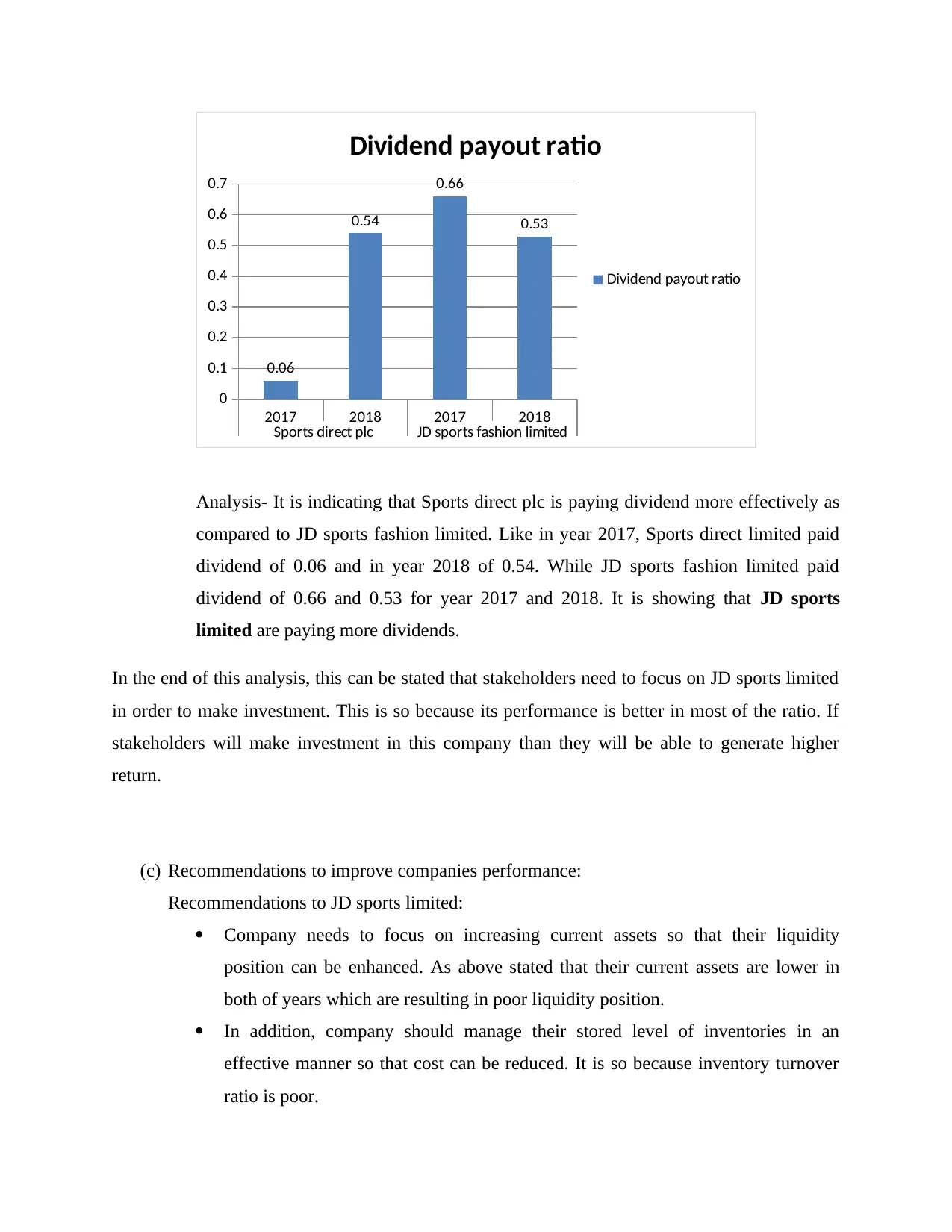
2017 2018 2017 2018
Sports direct plc JD sports fashion limited
0
0.1
0.2
0.3
0.4
0.5
0.6
0.7
0.06
0.54
0.66
0.53
Dividend payout ratio
Dividend payout ratio
Analysis- It is indicating that Sports direct plc is paying dividend more effectively as
compared to JD sports fashion limited. Like in year 2017, Sports direct limited paid
dividend of 0.06 and in year 2018 of 0.54. While JD sports fashion limited paid
dividend of 0.66 and 0.53 for year 2017 and 2018. It is showing that JD sports
limited are paying more dividends.
In the end of this analysis, this can be stated that stakeholders need to focus on JD sports limited
in order to make investment. This is so because its performance is better in most of the ratio. If
stakeholders will make investment in this company than they will be able to generate higher
return.
(c) Recommendations to improve companies performance:
Recommendations to JD sports limited:
Company needs to focus on increasing current assets so that their liquidity
position can be enhanced. As above stated that their current assets are lower in
both of years which are resulting in poor liquidity position.
In addition, company should manage their stored level of inventories in an
effective manner so that cost can be reduced. It is so because inventory turnover
ratio is poor.
Sports direct plc JD sports fashion limited
0
0.1
0.2
0.3
0.4
0.5
0.6
0.7
0.06
0.54
0.66
0.53
Dividend payout ratio
Dividend payout ratio
Analysis- It is indicating that Sports direct plc is paying dividend more effectively as
compared to JD sports fashion limited. Like in year 2017, Sports direct limited paid
dividend of 0.06 and in year 2018 of 0.54. While JD sports fashion limited paid
dividend of 0.66 and 0.53 for year 2017 and 2018. It is showing that JD sports
limited are paying more dividends.
In the end of this analysis, this can be stated that stakeholders need to focus on JD sports limited
in order to make investment. This is so because its performance is better in most of the ratio. If
stakeholders will make investment in this company than they will be able to generate higher
return.
(c) Recommendations to improve companies performance:
Recommendations to JD sports limited:
Company needs to focus on increasing current assets so that their liquidity
position can be enhanced. As above stated that their current assets are lower in
both of years which are resulting in poor liquidity position.
In addition, company should manage their stored level of inventories in an
effective manner so that cost can be reduced. It is so because inventory turnover
ratio is poor.
You're viewing a preview
Unlock full access by subscribing today!
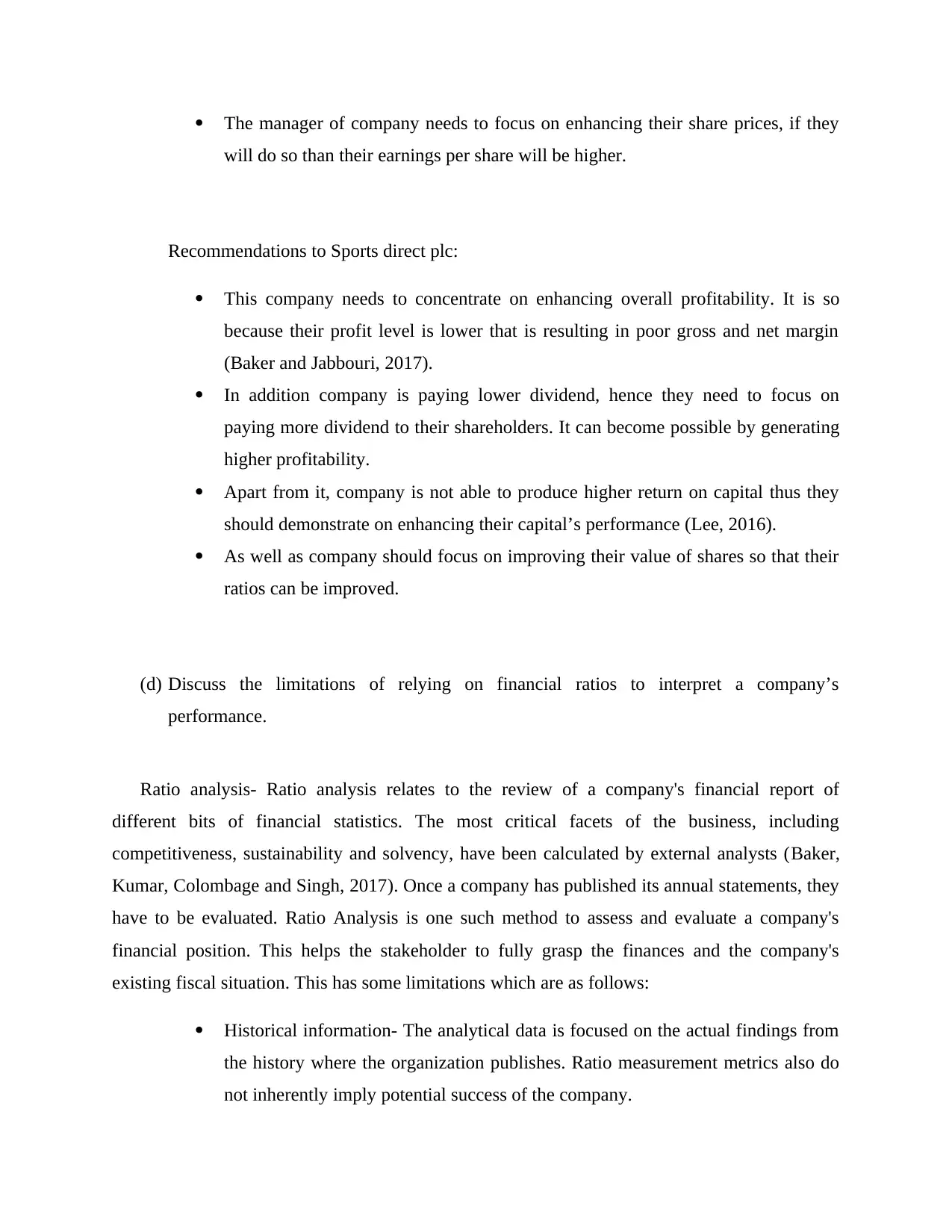
The manager of company needs to focus on enhancing their share prices, if they
will do so than their earnings per share will be higher.
Recommendations to Sports direct plc:
This company needs to concentrate on enhancing overall profitability. It is so
because their profit level is lower that is resulting in poor gross and net margin
(Baker and Jabbouri, 2017).
In addition company is paying lower dividend, hence they need to focus on
paying more dividend to their shareholders. It can become possible by generating
higher profitability.
Apart from it, company is not able to produce higher return on capital thus they
should demonstrate on enhancing their capital’s performance (Lee, 2016).
As well as company should focus on improving their value of shares so that their
ratios can be improved.
(d) Discuss the limitations of relying on financial ratios to interpret a company’s
performance.
Ratio analysis- Ratio analysis relates to the review of a company's financial report of
different bits of financial statistics. The most critical facets of the business, including
competitiveness, sustainability and solvency, have been calculated by external analysts (Baker,
Kumar, Colombage and Singh, 2017). Once a company has published its annual statements, they
have to be evaluated. Ratio Analysis is one such method to assess and evaluate a company's
financial position. This helps the stakeholder to fully grasp the finances and the company's
existing fiscal situation. This has some limitations which are as follows:
Historical information- The analytical data is focused on the actual findings from
the history where the organization publishes. Ratio measurement metrics also do
not inherently imply potential success of the company.
will do so than their earnings per share will be higher.
Recommendations to Sports direct plc:
This company needs to concentrate on enhancing overall profitability. It is so
because their profit level is lower that is resulting in poor gross and net margin
(Baker and Jabbouri, 2017).
In addition company is paying lower dividend, hence they need to focus on
paying more dividend to their shareholders. It can become possible by generating
higher profitability.
Apart from it, company is not able to produce higher return on capital thus they
should demonstrate on enhancing their capital’s performance (Lee, 2016).
As well as company should focus on improving their value of shares so that their
ratios can be improved.
(d) Discuss the limitations of relying on financial ratios to interpret a company’s
performance.
Ratio analysis- Ratio analysis relates to the review of a company's financial report of
different bits of financial statistics. The most critical facets of the business, including
competitiveness, sustainability and solvency, have been calculated by external analysts (Baker,
Kumar, Colombage and Singh, 2017). Once a company has published its annual statements, they
have to be evaluated. Ratio Analysis is one such method to assess and evaluate a company's
financial position. This helps the stakeholder to fully grasp the finances and the company's
existing fiscal situation. This has some limitations which are as follows:
Historical information- The analytical data is focused on the actual findings from
the history where the organization publishes. Ratio measurement metrics also do
not inherently imply potential success of the company.
Paraphrase This Document
Need a fresh take? Get an instant paraphrase of this document with our AI Paraphraser
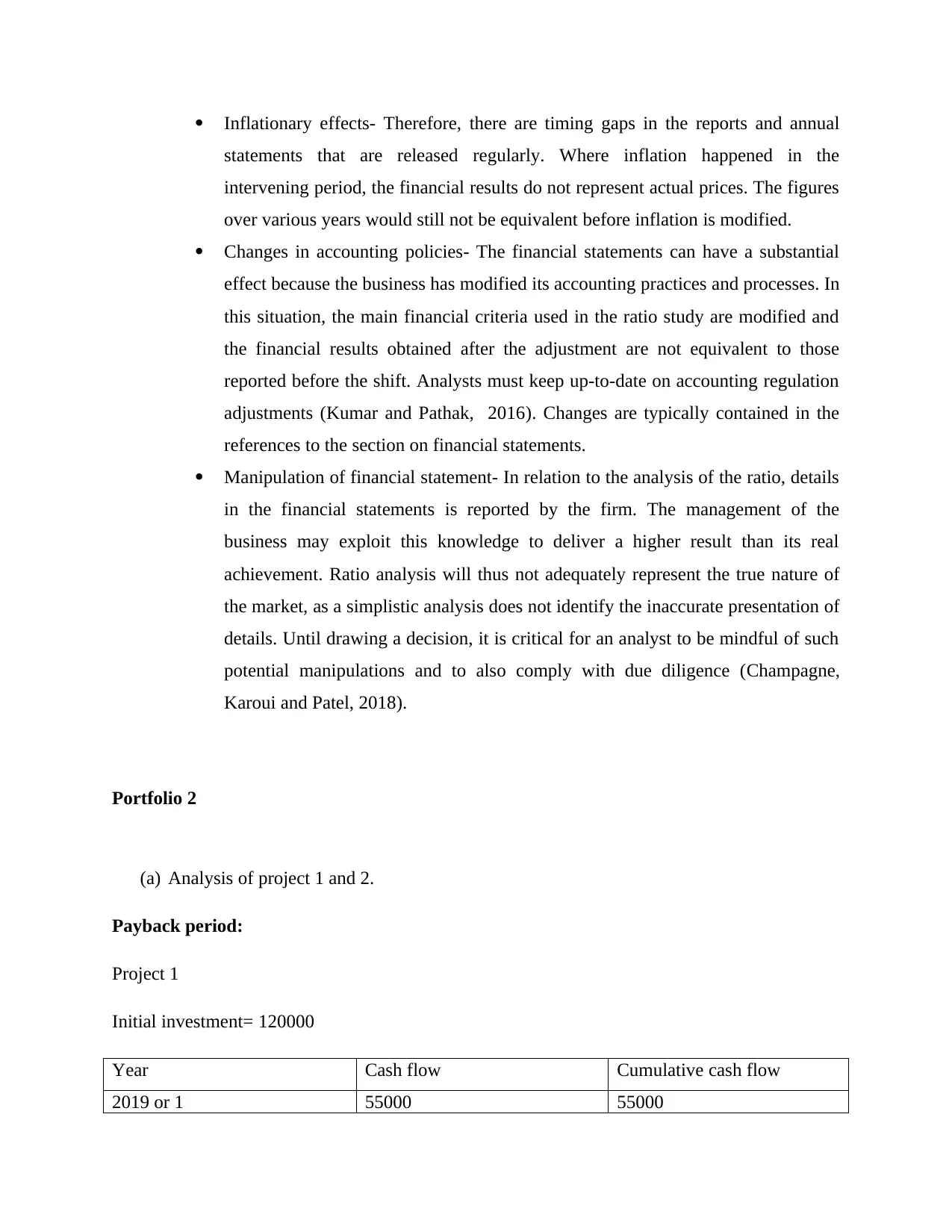
Inflationary effects- Therefore, there are timing gaps in the reports and annual
statements that are released regularly. Where inflation happened in the
intervening period, the financial results do not represent actual prices. The figures
over various years would still not be equivalent before inflation is modified.
Changes in accounting policies- The financial statements can have a substantial
effect because the business has modified its accounting practices and processes. In
this situation, the main financial criteria used in the ratio study are modified and
the financial results obtained after the adjustment are not equivalent to those
reported before the shift. Analysts must keep up-to-date on accounting regulation
adjustments (Kumar and Pathak, 2016). Changes are typically contained in the
references to the section on financial statements.
Manipulation of financial statement- In relation to the analysis of the ratio, details
in the financial statements is reported by the firm. The management of the
business may exploit this knowledge to deliver a higher result than its real
achievement. Ratio analysis will thus not adequately represent the true nature of
the market, as a simplistic analysis does not identify the inaccurate presentation of
details. Until drawing a decision, it is critical for an analyst to be mindful of such
potential manipulations and to also comply with due diligence (Champagne,
Karoui and Patel, 2018).
Portfolio 2
(a) Analysis of project 1 and 2.
Payback period:
Project 1
Initial investment= 120000
Year Cash flow Cumulative cash flow
2019 or 1 55000 55000
statements that are released regularly. Where inflation happened in the
intervening period, the financial results do not represent actual prices. The figures
over various years would still not be equivalent before inflation is modified.
Changes in accounting policies- The financial statements can have a substantial
effect because the business has modified its accounting practices and processes. In
this situation, the main financial criteria used in the ratio study are modified and
the financial results obtained after the adjustment are not equivalent to those
reported before the shift. Analysts must keep up-to-date on accounting regulation
adjustments (Kumar and Pathak, 2016). Changes are typically contained in the
references to the section on financial statements.
Manipulation of financial statement- In relation to the analysis of the ratio, details
in the financial statements is reported by the firm. The management of the
business may exploit this knowledge to deliver a higher result than its real
achievement. Ratio analysis will thus not adequately represent the true nature of
the market, as a simplistic analysis does not identify the inaccurate presentation of
details. Until drawing a decision, it is critical for an analyst to be mindful of such
potential manipulations and to also comply with due diligence (Champagne,
Karoui and Patel, 2018).
Portfolio 2
(a) Analysis of project 1 and 2.
Payback period:
Project 1
Initial investment= 120000
Year Cash flow Cumulative cash flow
2019 or 1 55000 55000
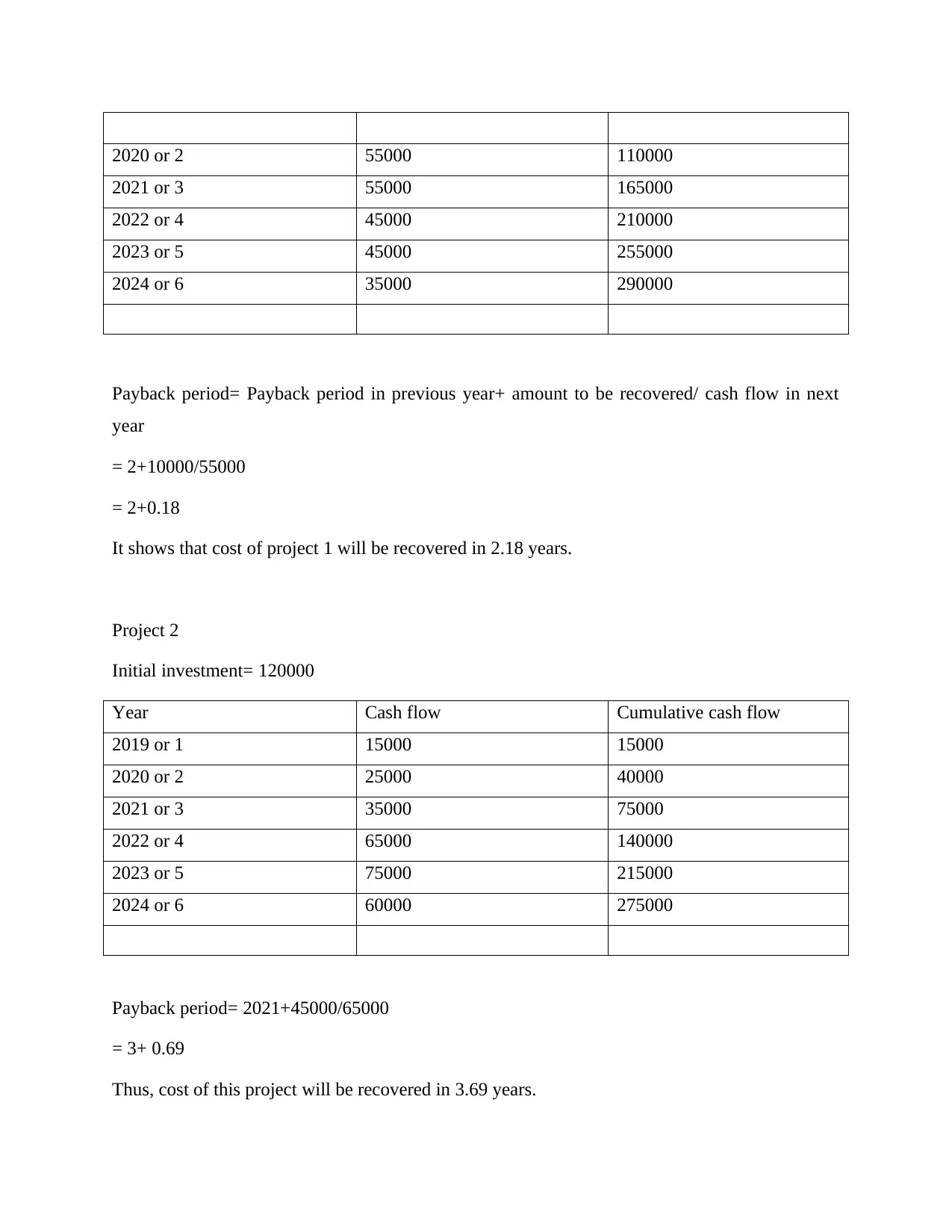
2020 or 2 55000 110000
2021 or 3 55000 165000
2022 or 4 45000 210000
2023 or 5 45000 255000
2024 or 6 35000 290000
Payback period= Payback period in previous year+ amount to be recovered/ cash flow in next
year
= 2+10000/55000
= 2+0.18
It shows that cost of project 1 will be recovered in 2.18 years.
Project 2
Initial investment= 120000
Year Cash flow Cumulative cash flow
2019 or 1 15000 15000
2020 or 2 25000 40000
2021 or 3 35000 75000
2022 or 4 65000 140000
2023 or 5 75000 215000
2024 or 6 60000 275000
Payback period= 2021+45000/65000
= 3+ 0.69
Thus, cost of this project will be recovered in 3.69 years.
2021 or 3 55000 165000
2022 or 4 45000 210000
2023 or 5 45000 255000
2024 or 6 35000 290000
Payback period= Payback period in previous year+ amount to be recovered/ cash flow in next
year
= 2+10000/55000
= 2+0.18
It shows that cost of project 1 will be recovered in 2.18 years.
Project 2
Initial investment= 120000
Year Cash flow Cumulative cash flow
2019 or 1 15000 15000
2020 or 2 25000 40000
2021 or 3 35000 75000
2022 or 4 65000 140000
2023 or 5 75000 215000
2024 or 6 60000 275000
Payback period= 2021+45000/65000
= 3+ 0.69
Thus, cost of this project will be recovered in 3.69 years.
You're viewing a preview
Unlock full access by subscribing today!
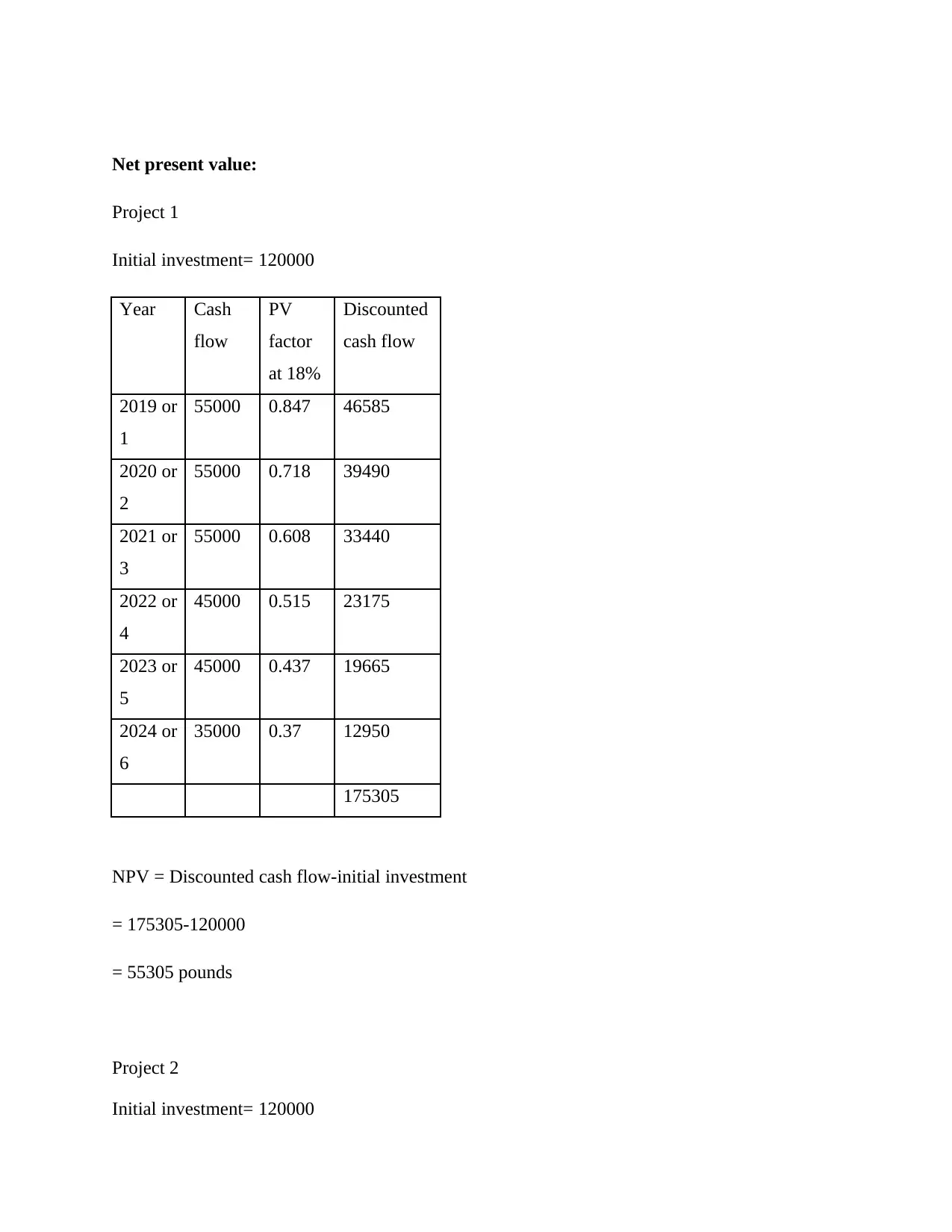
Net present value:
Project 1
Initial investment= 120000
Year Cash
flow
PV
factor
at 18%
Discounted
cash flow
2019 or
1
55000 0.847 46585
2020 or
2
55000 0.718 39490
2021 or
3
55000 0.608 33440
2022 or
4
45000 0.515 23175
2023 or
5
45000 0.437 19665
2024 or
6
35000 0.37 12950
175305
NPV = Discounted cash flow-initial investment
= 175305-120000
= 55305 pounds
Project 2
Initial investment= 120000
Project 1
Initial investment= 120000
Year Cash
flow
PV
factor
at 18%
Discounted
cash flow
2019 or
1
55000 0.847 46585
2020 or
2
55000 0.718 39490
2021 or
3
55000 0.608 33440
2022 or
4
45000 0.515 23175
2023 or
5
45000 0.437 19665
2024 or
6
35000 0.37 12950
175305
NPV = Discounted cash flow-initial investment
= 175305-120000
= 55305 pounds
Project 2
Initial investment= 120000
Paraphrase This Document
Need a fresh take? Get an instant paraphrase of this document with our AI Paraphraser
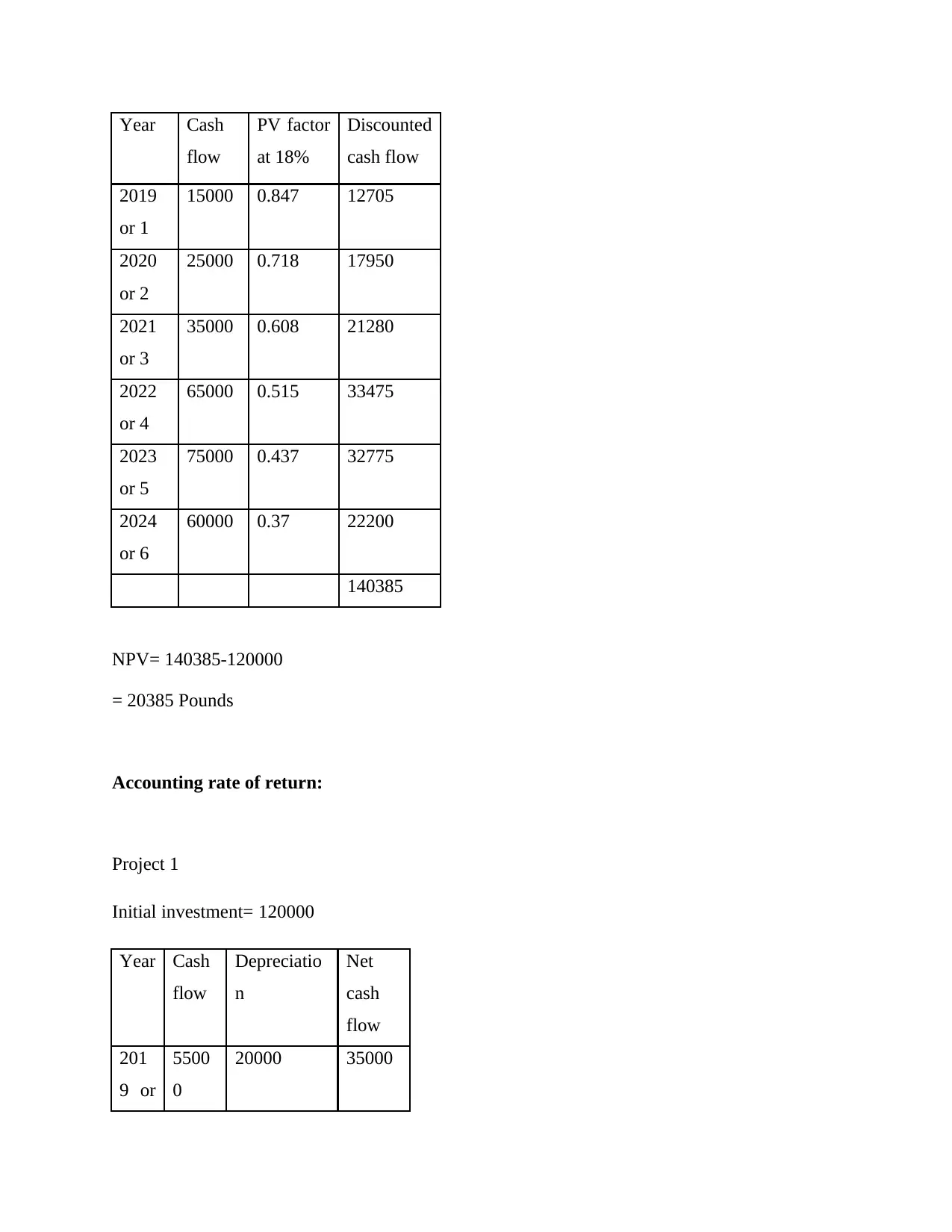
Year Cash
flow
PV factor
at 18%
Discounted
cash flow
2019
or 1
15000 0.847 12705
2020
or 2
25000 0.718 17950
2021
or 3
35000 0.608 21280
2022
or 4
65000 0.515 33475
2023
or 5
75000 0.437 32775
2024
or 6
60000 0.37 22200
140385
NPV= 140385-120000
= 20385 Pounds
Accounting rate of return:
Project 1
Initial investment= 120000
Year Cash
flow
Depreciatio
n
Net
cash
flow
201
9 or
5500
0
20000 35000
flow
PV factor
at 18%
Discounted
cash flow
2019
or 1
15000 0.847 12705
2020
or 2
25000 0.718 17950
2021
or 3
35000 0.608 21280
2022
or 4
65000 0.515 33475
2023
or 5
75000 0.437 32775
2024
or 6
60000 0.37 22200
140385
NPV= 140385-120000
= 20385 Pounds
Accounting rate of return:
Project 1
Initial investment= 120000
Year Cash
flow
Depreciatio
n
Net
cash
flow
201
9 or
5500
0
20000 35000
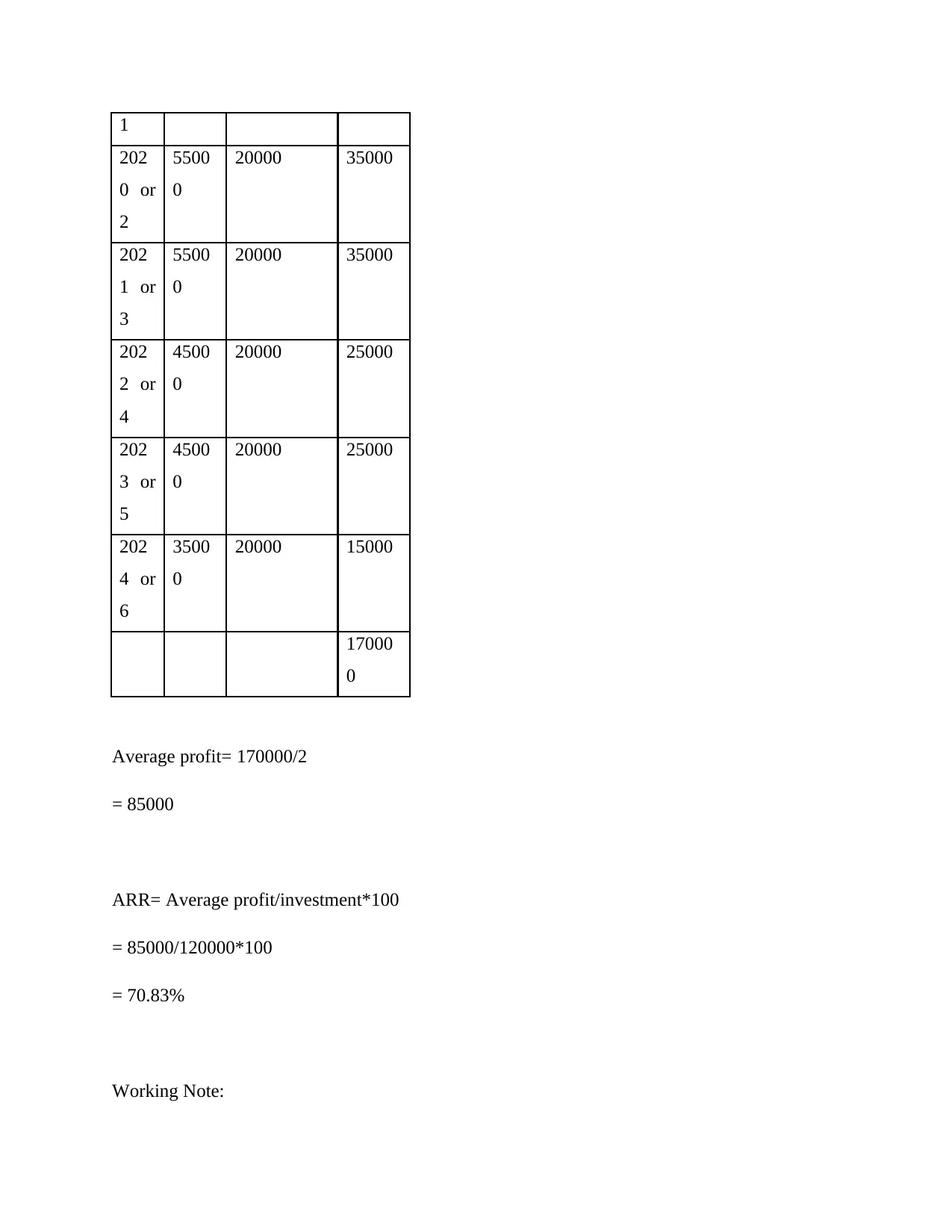
1
202
0 or
2
5500
0
20000 35000
202
1 or
3
5500
0
20000 35000
202
2 or
4
4500
0
20000 25000
202
3 or
5
4500
0
20000 25000
202
4 or
6
3500
0
20000 15000
17000
0
Average profit= 170000/2
= 85000
ARR= Average profit/investment*100
= 85000/120000*100
= 70.83%
Working Note:
202
0 or
2
5500
0
20000 35000
202
1 or
3
5500
0
20000 35000
202
2 or
4
4500
0
20000 25000
202
3 or
5
4500
0
20000 25000
202
4 or
6
3500
0
20000 15000
17000
0
Average profit= 170000/2
= 85000
ARR= Average profit/investment*100
= 85000/120000*100
= 70.83%
Working Note:
You're viewing a preview
Unlock full access by subscribing today!
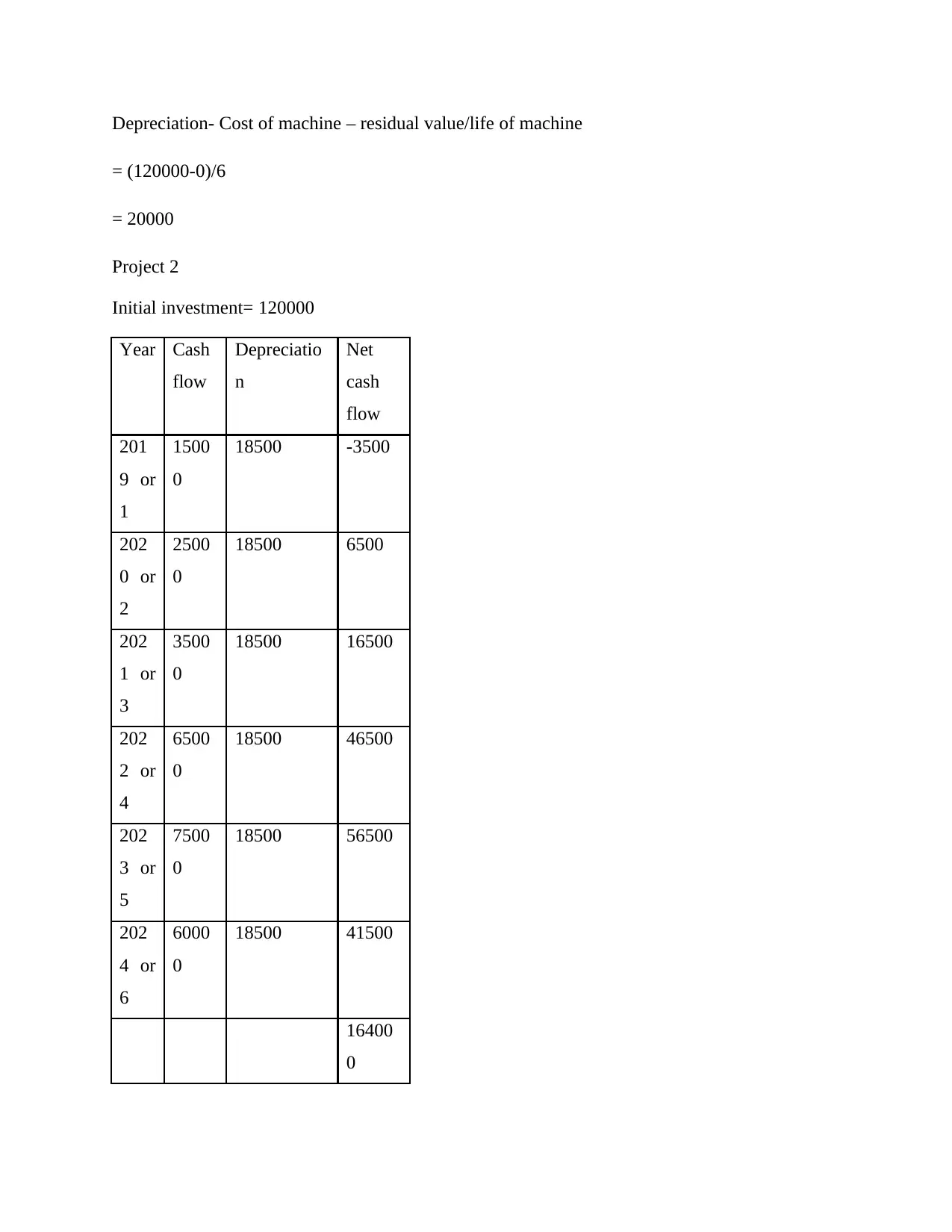
Depreciation- Cost of machine – residual value/life of machine
= (120000-0)/6
= 20000
Project 2
Initial investment= 120000
Year Cash
flow
Depreciatio
n
Net
cash
flow
201
9 or
1
1500
0
18500 -3500
202
0 or
2
2500
0
18500 6500
202
1 or
3
3500
0
18500 16500
202
2 or
4
6500
0
18500 46500
202
3 or
5
7500
0
18500 56500
202
4 or
6
6000
0
18500 41500
16400
0
= (120000-0)/6
= 20000
Project 2
Initial investment= 120000
Year Cash
flow
Depreciatio
n
Net
cash
flow
201
9 or
1
1500
0
18500 -3500
202
0 or
2
2500
0
18500 6500
202
1 or
3
3500
0
18500 16500
202
2 or
4
6500
0
18500 46500
202
3 or
5
7500
0
18500 56500
202
4 or
6
6000
0
18500 41500
16400
0
Paraphrase This Document
Need a fresh take? Get an instant paraphrase of this document with our AI Paraphraser
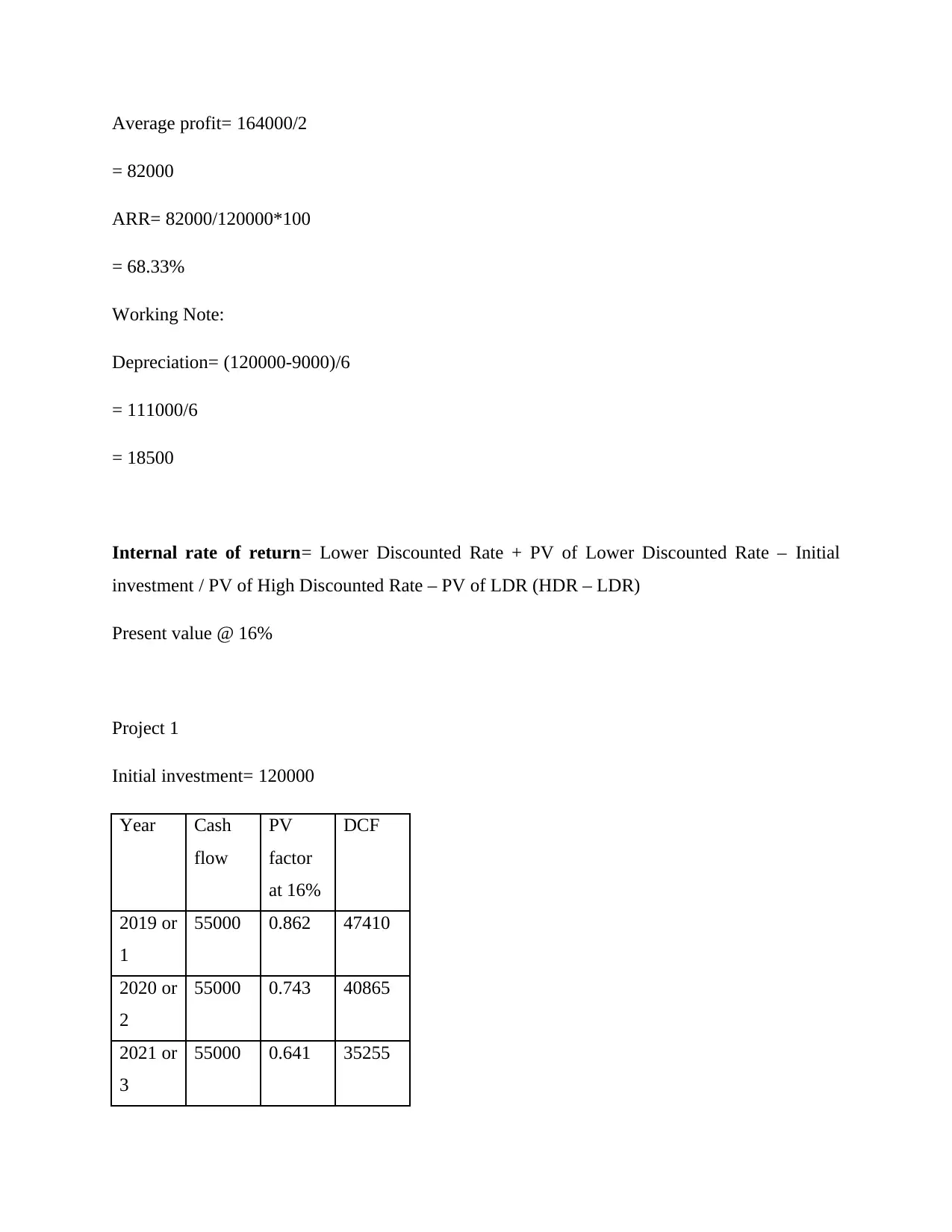
Average profit= 164000/2
= 82000
ARR= 82000/120000*100
= 68.33%
Working Note:
Depreciation= (120000-9000)/6
= 111000/6
= 18500
Internal rate of return= Lower Discounted Rate + PV of Lower Discounted Rate – Initial
investment / PV of High Discounted Rate – PV of LDR (HDR – LDR)
Present value @ 16%
Project 1
Initial investment= 120000
Year Cash
flow
PV
factor
at 16%
DCF
2019 or
1
55000 0.862 47410
2020 or
2
55000 0.743 40865
2021 or
3
55000 0.641 35255
= 82000
ARR= 82000/120000*100
= 68.33%
Working Note:
Depreciation= (120000-9000)/6
= 111000/6
= 18500
Internal rate of return= Lower Discounted Rate + PV of Lower Discounted Rate – Initial
investment / PV of High Discounted Rate – PV of LDR (HDR – LDR)
Present value @ 16%
Project 1
Initial investment= 120000
Year Cash
flow
PV
factor
at 16%
DCF
2019 or
1
55000 0.862 47410
2020 or
2
55000 0.743 40865
2021 or
3
55000 0.641 35255

2022 or
4
45000 0.552 24840
2023 or
5
45000 0.476 21420
2024 or
6
35000 0.41 14350
184140
NPV= 184140-120000
= 64140
NPV at 20%
Year Cash
flow
PV
factor
at 20%
DCF
2019 or
1
55000 0.833 45815
2020 or
2
55000 0.694 38170
2021 or
3
55000 0.579 31845
2022 or
4
45000 0.482 21690
2023 or
5
45000 0.402 18090
2024 or
6
35000 0.335 11725
167335
4
45000 0.552 24840
2023 or
5
45000 0.476 21420
2024 or
6
35000 0.41 14350
184140
NPV= 184140-120000
= 64140
NPV at 20%
Year Cash
flow
PV
factor
at 20%
DCF
2019 or
1
55000 0.833 45815
2020 or
2
55000 0.694 38170
2021 or
3
55000 0.579 31845
2022 or
4
45000 0.482 21690
2023 or
5
45000 0.402 18090
2024 or
6
35000 0.335 11725
167335
You're viewing a preview
Unlock full access by subscribing today!
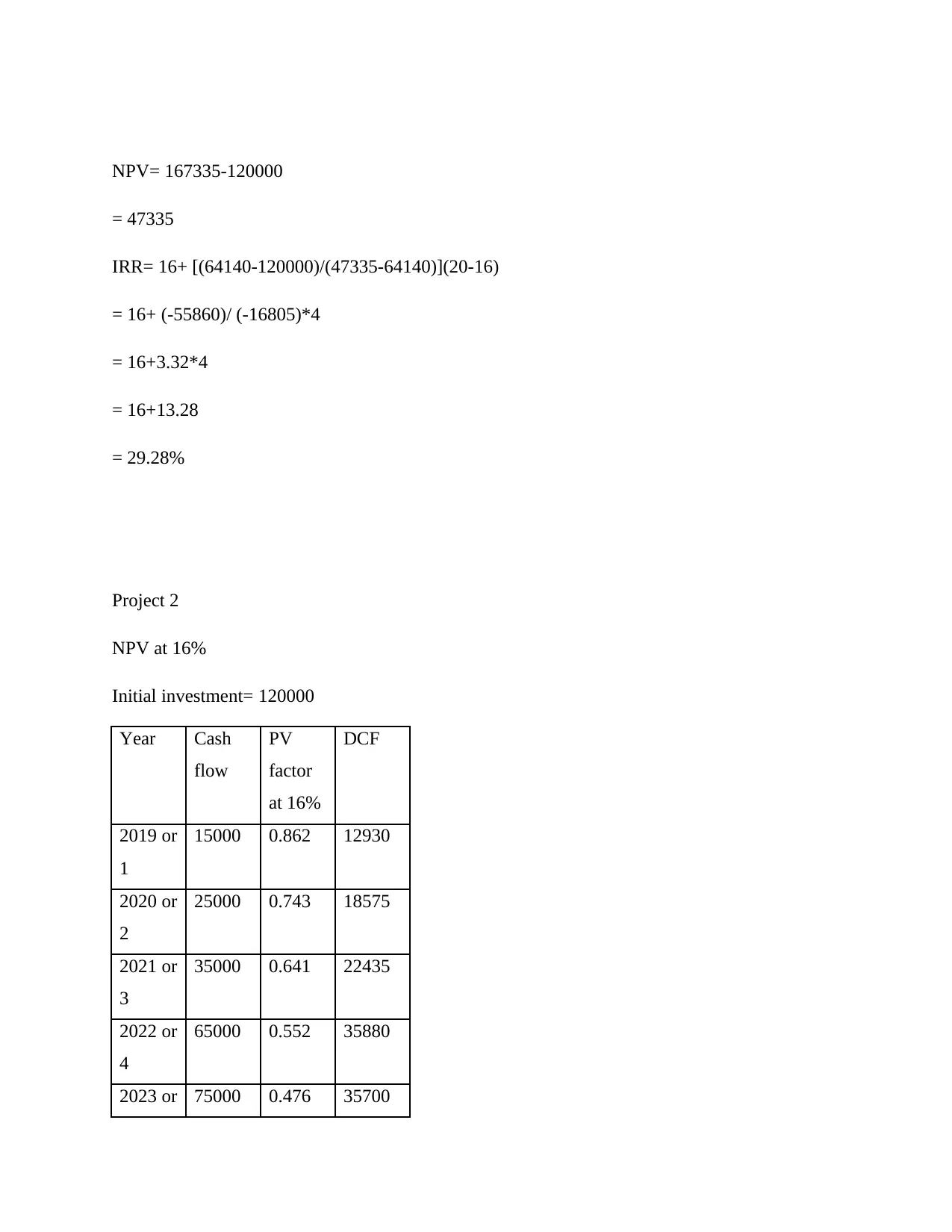
NPV= 167335-120000
= 47335
IRR= 16+ [(64140-120000)/(47335-64140)](20-16)
= 16+ (-55860)/ (-16805)*4
= 16+3.32*4
= 16+13.28
= 29.28%
Project 2
NPV at 16%
Initial investment= 120000
Year Cash
flow
PV
factor
at 16%
DCF
2019 or
1
15000 0.862 12930
2020 or
2
25000 0.743 18575
2021 or
3
35000 0.641 22435
2022 or
4
65000 0.552 35880
2023 or 75000 0.476 35700
= 47335
IRR= 16+ [(64140-120000)/(47335-64140)](20-16)
= 16+ (-55860)/ (-16805)*4
= 16+3.32*4
= 16+13.28
= 29.28%
Project 2
NPV at 16%
Initial investment= 120000
Year Cash
flow
PV
factor
at 16%
DCF
2019 or
1
15000 0.862 12930
2020 or
2
25000 0.743 18575
2021 or
3
35000 0.641 22435
2022 or
4
65000 0.552 35880
2023 or 75000 0.476 35700
Paraphrase This Document
Need a fresh take? Get an instant paraphrase of this document with our AI Paraphraser
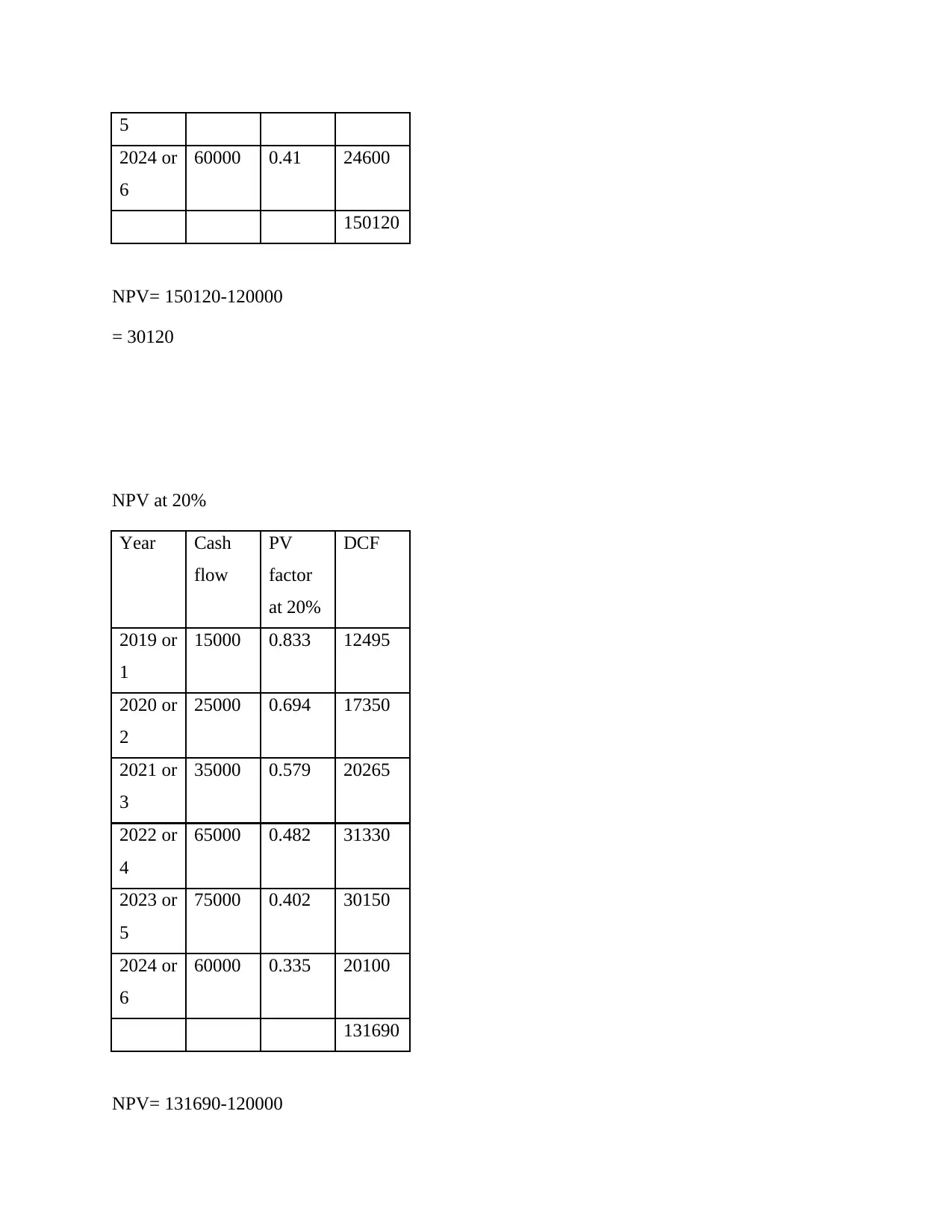
5
2024 or
6
60000 0.41 24600
150120
NPV= 150120-120000
= 30120
NPV at 20%
Year Cash
flow
PV
factor
at 20%
DCF
2019 or
1
15000 0.833 12495
2020 or
2
25000 0.694 17350
2021 or
3
35000 0.579 20265
2022 or
4
65000 0.482 31330
2023 or
5
75000 0.402 30150
2024 or
6
60000 0.335 20100
131690
NPV= 131690-120000
2024 or
6
60000 0.41 24600
150120
NPV= 150120-120000
= 30120
NPV at 20%
Year Cash
flow
PV
factor
at 20%
DCF
2019 or
1
15000 0.833 12495
2020 or
2
25000 0.694 17350
2021 or
3
35000 0.579 20265
2022 or
4
65000 0.482 31330
2023 or
5
75000 0.402 30150
2024 or
6
60000 0.335 20100
131690
NPV= 131690-120000
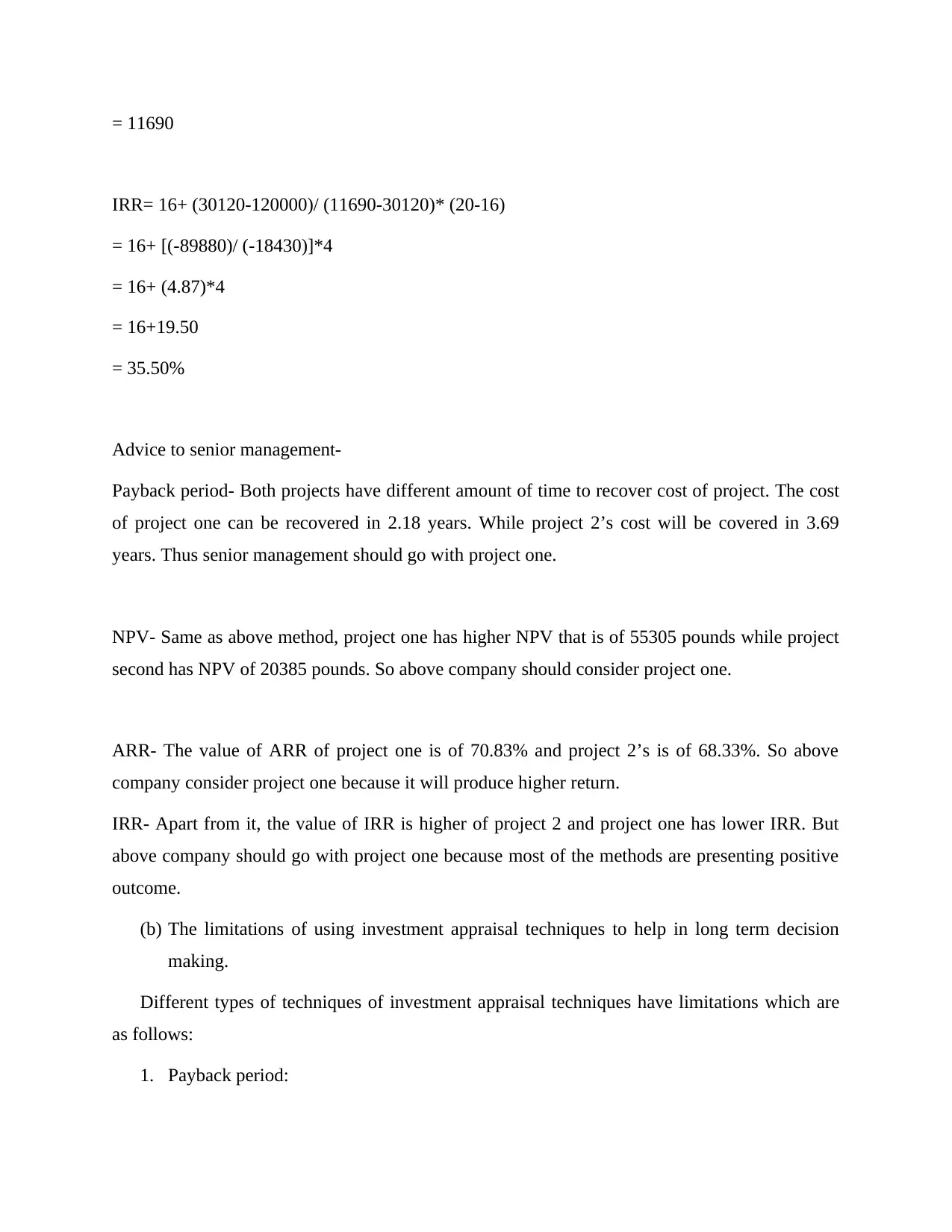
= 11690
IRR= 16+ (30120-120000)/ (11690-30120)* (20-16)
= 16+ [(-89880)/ (-18430)]*4
= 16+ (4.87)*4
= 16+19.50
= 35.50%
Advice to senior management-
Payback period- Both projects have different amount of time to recover cost of project. The cost
of project one can be recovered in 2.18 years. While project 2’s cost will be covered in 3.69
years. Thus senior management should go with project one.
NPV- Same as above method, project one has higher NPV that is of 55305 pounds while project
second has NPV of 20385 pounds. So above company should consider project one.
ARR- The value of ARR of project one is of 70.83% and project 2’s is of 68.33%. So above
company consider project one because it will produce higher return.
IRR- Apart from it, the value of IRR is higher of project 2 and project one has lower IRR. But
above company should go with project one because most of the methods are presenting positive
outcome.
(b) The limitations of using investment appraisal techniques to help in long term decision
making.
Different types of techniques of investment appraisal techniques have limitations which are
as follows:
1. Payback period:
IRR= 16+ (30120-120000)/ (11690-30120)* (20-16)
= 16+ [(-89880)/ (-18430)]*4
= 16+ (4.87)*4
= 16+19.50
= 35.50%
Advice to senior management-
Payback period- Both projects have different amount of time to recover cost of project. The cost
of project one can be recovered in 2.18 years. While project 2’s cost will be covered in 3.69
years. Thus senior management should go with project one.
NPV- Same as above method, project one has higher NPV that is of 55305 pounds while project
second has NPV of 20385 pounds. So above company should consider project one.
ARR- The value of ARR of project one is of 70.83% and project 2’s is of 68.33%. So above
company consider project one because it will produce higher return.
IRR- Apart from it, the value of IRR is higher of project 2 and project one has lower IRR. But
above company should go with project one because most of the methods are presenting positive
outcome.
(b) The limitations of using investment appraisal techniques to help in long term decision
making.
Different types of techniques of investment appraisal techniques have limitations which are
as follows:
1. Payback period:
You're viewing a preview
Unlock full access by subscribing today!
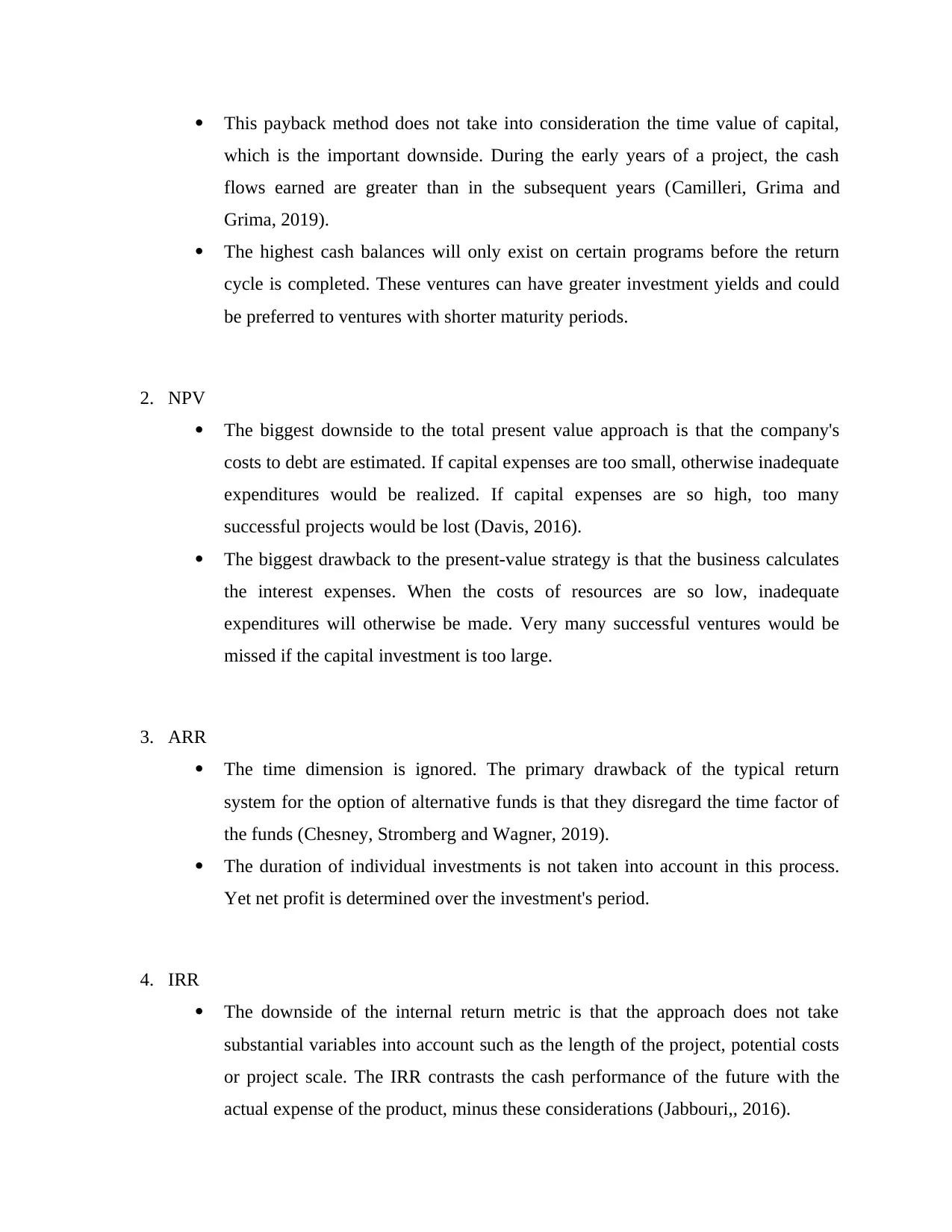
This payback method does not take into consideration the time value of capital,
which is the important downside. During the early years of a project, the cash
flows earned are greater than in the subsequent years (Camilleri, Grima and
Grima, 2019).
The highest cash balances will only exist on certain programs before the return
cycle is completed. These ventures can have greater investment yields and could
be preferred to ventures with shorter maturity periods.
2. NPV
The biggest downside to the total present value approach is that the company's
costs to debt are estimated. If capital expenses are too small, otherwise inadequate
expenditures would be realized. If capital expenses are so high, too many
successful projects would be lost (Davis, 2016).
The biggest drawback to the present-value strategy is that the business calculates
the interest expenses. When the costs of resources are so low, inadequate
expenditures will otherwise be made. Very many successful ventures would be
missed if the capital investment is too large.
3. ARR
The time dimension is ignored. The primary drawback of the typical return
system for the option of alternative funds is that they disregard the time factor of
the funds (Chesney, Stromberg and Wagner, 2019).
The duration of individual investments is not taken into account in this process.
Yet net profit is determined over the investment's period.
4. IRR
The downside of the internal return metric is that the approach does not take
substantial variables into account such as the length of the project, potential costs
or project scale. The IRR contrasts the cash performance of the future with the
actual expense of the product, minus these considerations (Jabbouri,, 2016).
which is the important downside. During the early years of a project, the cash
flows earned are greater than in the subsequent years (Camilleri, Grima and
Grima, 2019).
The highest cash balances will only exist on certain programs before the return
cycle is completed. These ventures can have greater investment yields and could
be preferred to ventures with shorter maturity periods.
2. NPV
The biggest downside to the total present value approach is that the company's
costs to debt are estimated. If capital expenses are too small, otherwise inadequate
expenditures would be realized. If capital expenses are so high, too many
successful projects would be lost (Davis, 2016).
The biggest drawback to the present-value strategy is that the business calculates
the interest expenses. When the costs of resources are so low, inadequate
expenditures will otherwise be made. Very many successful ventures would be
missed if the capital investment is too large.
3. ARR
The time dimension is ignored. The primary drawback of the typical return
system for the option of alternative funds is that they disregard the time factor of
the funds (Chesney, Stromberg and Wagner, 2019).
The duration of individual investments is not taken into account in this process.
Yet net profit is determined over the investment's period.
4. IRR
The downside of the internal return metric is that the approach does not take
substantial variables into account such as the length of the project, potential costs
or project scale. The IRR contrasts the cash performance of the future with the
actual expense of the product, minus these considerations (Jabbouri,, 2016).
Paraphrase This Document
Need a fresh take? Get an instant paraphrase of this document with our AI Paraphraser
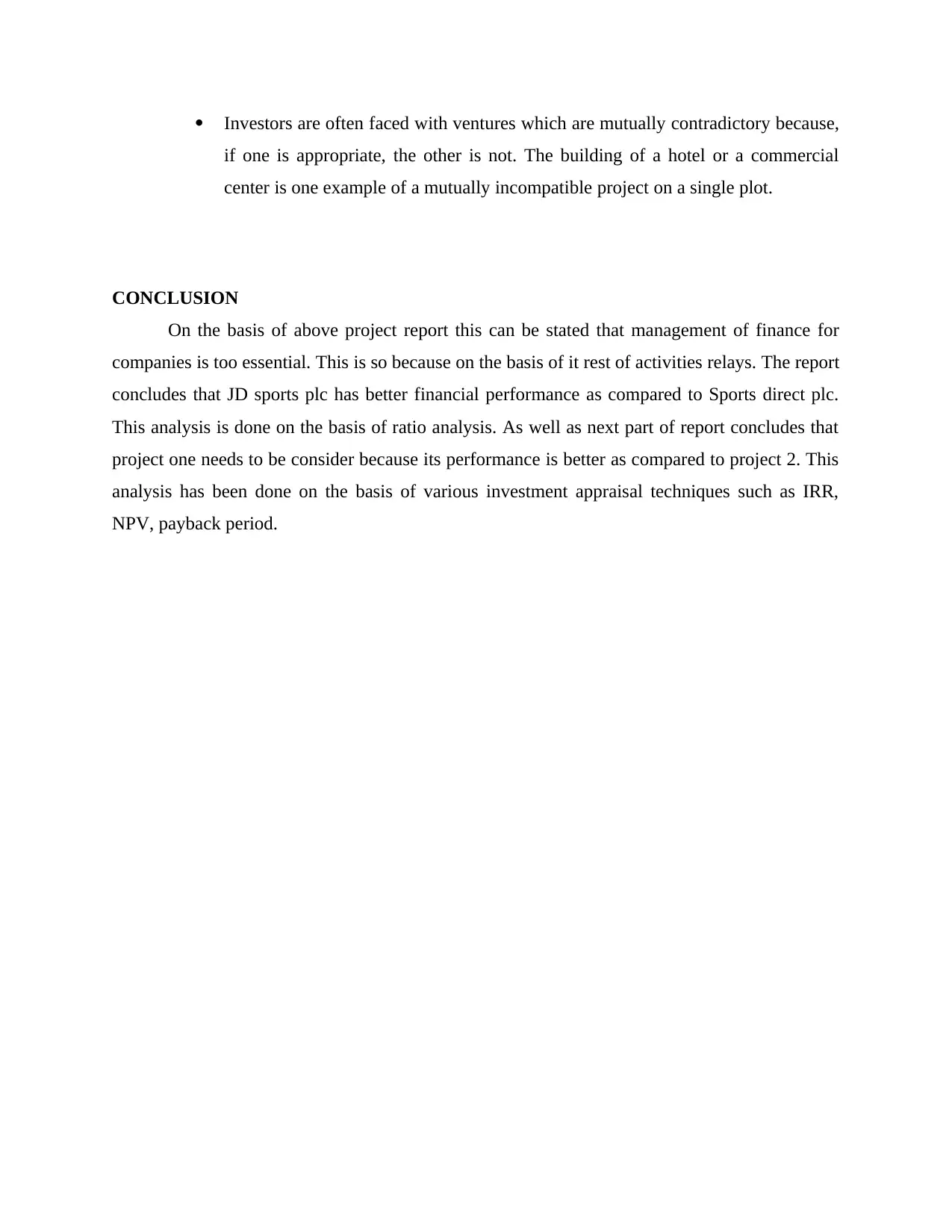
Investors are often faced with ventures which are mutually contradictory because,
if one is appropriate, the other is not. The building of a hotel or a commercial
center is one example of a mutually incompatible project on a single plot.
CONCLUSION
On the basis of above project report this can be stated that management of finance for
companies is too essential. This is so because on the basis of it rest of activities relays. The report
concludes that JD sports plc has better financial performance as compared to Sports direct plc.
This analysis is done on the basis of ratio analysis. As well as next part of report concludes that
project one needs to be consider because its performance is better as compared to project 2. This
analysis has been done on the basis of various investment appraisal techniques such as IRR,
NPV, payback period.
if one is appropriate, the other is not. The building of a hotel or a commercial
center is one example of a mutually incompatible project on a single plot.
CONCLUSION
On the basis of above project report this can be stated that management of finance for
companies is too essential. This is so because on the basis of it rest of activities relays. The report
concludes that JD sports plc has better financial performance as compared to Sports direct plc.
This analysis is done on the basis of ratio analysis. As well as next part of report concludes that
project one needs to be consider because its performance is better as compared to project 2. This
analysis has been done on the basis of various investment appraisal techniques such as IRR,
NPV, payback period.
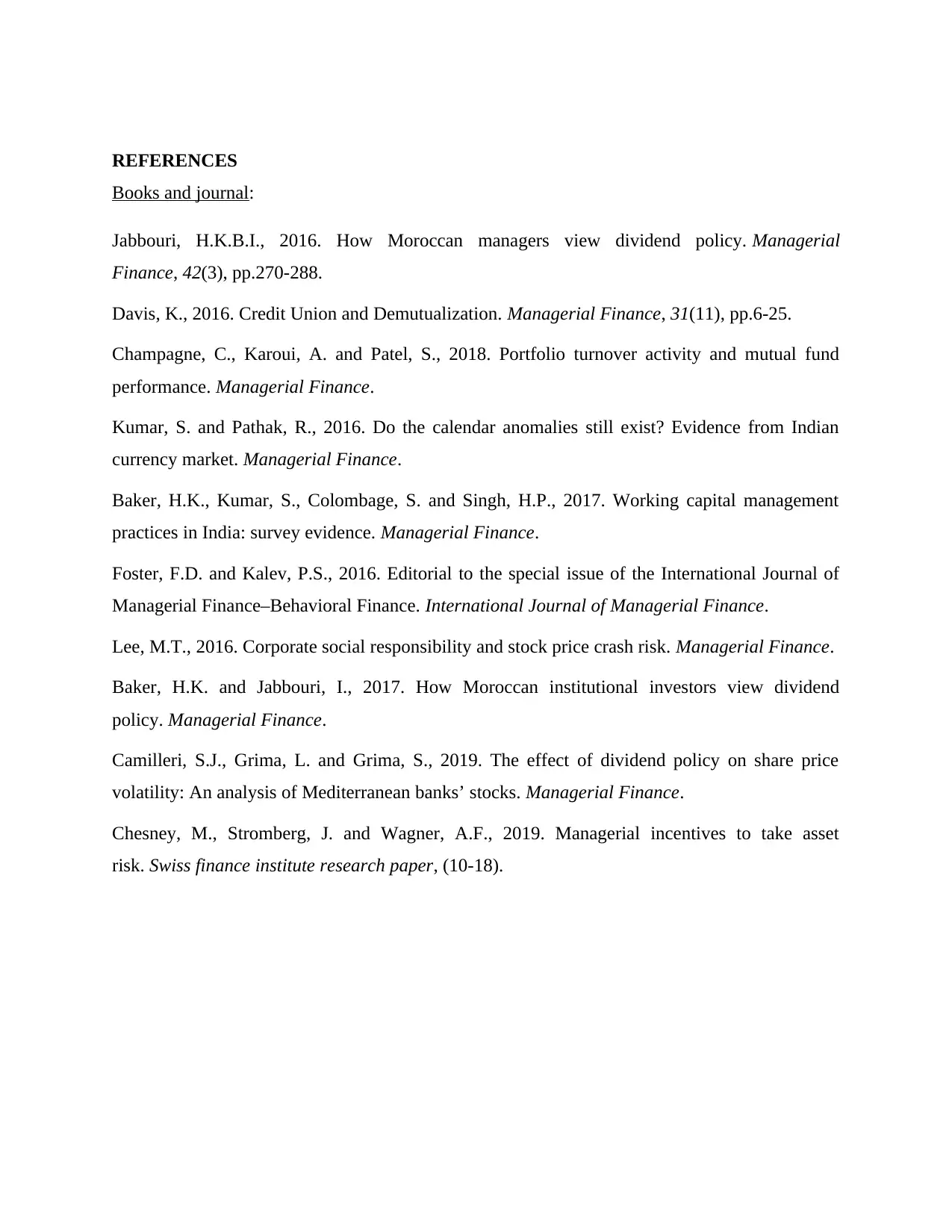
REFERENCES
Books and journal:
Jabbouri, H.K.B.I., 2016. How Moroccan managers view dividend policy. Managerial
Finance, 42(3), pp.270-288.
Davis, K., 2016. Credit Union and Demutualization. Managerial Finance, 31(11), pp.6-25.
Champagne, C., Karoui, A. and Patel, S., 2018. Portfolio turnover activity and mutual fund
performance. Managerial Finance.
Kumar, S. and Pathak, R., 2016. Do the calendar anomalies still exist? Evidence from Indian
currency market. Managerial Finance.
Baker, H.K., Kumar, S., Colombage, S. and Singh, H.P., 2017. Working capital management
practices in India: survey evidence. Managerial Finance.
Foster, F.D. and Kalev, P.S., 2016. Editorial to the special issue of the International Journal of
Managerial Finance–Behavioral Finance. International Journal of Managerial Finance.
Lee, M.T., 2016. Corporate social responsibility and stock price crash risk. Managerial Finance.
Baker, H.K. and Jabbouri, I., 2017. How Moroccan institutional investors view dividend
policy. Managerial Finance.
Camilleri, S.J., Grima, L. and Grima, S., 2019. The effect of dividend policy on share price
volatility: An analysis of Mediterranean banks’ stocks. Managerial Finance.
Chesney, M., Stromberg, J. and Wagner, A.F., 2019. Managerial incentives to take asset
risk. Swiss finance institute research paper, (10-18).
Books and journal:
Jabbouri, H.K.B.I., 2016. How Moroccan managers view dividend policy. Managerial
Finance, 42(3), pp.270-288.
Davis, K., 2016. Credit Union and Demutualization. Managerial Finance, 31(11), pp.6-25.
Champagne, C., Karoui, A. and Patel, S., 2018. Portfolio turnover activity and mutual fund
performance. Managerial Finance.
Kumar, S. and Pathak, R., 2016. Do the calendar anomalies still exist? Evidence from Indian
currency market. Managerial Finance.
Baker, H.K., Kumar, S., Colombage, S. and Singh, H.P., 2017. Working capital management
practices in India: survey evidence. Managerial Finance.
Foster, F.D. and Kalev, P.S., 2016. Editorial to the special issue of the International Journal of
Managerial Finance–Behavioral Finance. International Journal of Managerial Finance.
Lee, M.T., 2016. Corporate social responsibility and stock price crash risk. Managerial Finance.
Baker, H.K. and Jabbouri, I., 2017. How Moroccan institutional investors view dividend
policy. Managerial Finance.
Camilleri, S.J., Grima, L. and Grima, S., 2019. The effect of dividend policy on share price
volatility: An analysis of Mediterranean banks’ stocks. Managerial Finance.
Chesney, M., Stromberg, J. and Wagner, A.F., 2019. Managerial incentives to take asset
risk. Swiss finance institute research paper, (10-18).
You're viewing a preview
Unlock full access by subscribing today!
1 out of 27
Your All-in-One AI-Powered Toolkit for Academic Success.
+13062052269
info@desklib.com
Available 24*7 on WhatsApp / Email
![[object Object]](/_next/static/media/star-bottom.7253800d.svg)
Unlock your academic potential
© 2024 | Zucol Services PVT LTD | All rights reserved.